Exploring Learning Styles and Organisational Development
VerifiedAdded on 2020/02/17
|21
|6901
|89
AI Summary
This assignment explores the relationship between learning styles and organizational development. It requires students to analyze various learning style theories, including Kirkpatrick's model, and explore how different learning preferences can influence individual and organizational growth. The analysis should encompass practical examples and highlight the importance of understanding learning styles for effective training and development initiatives within organizations.
Contribute Materials
Your contribution can guide someone’s learning journey. Share your
documents today.
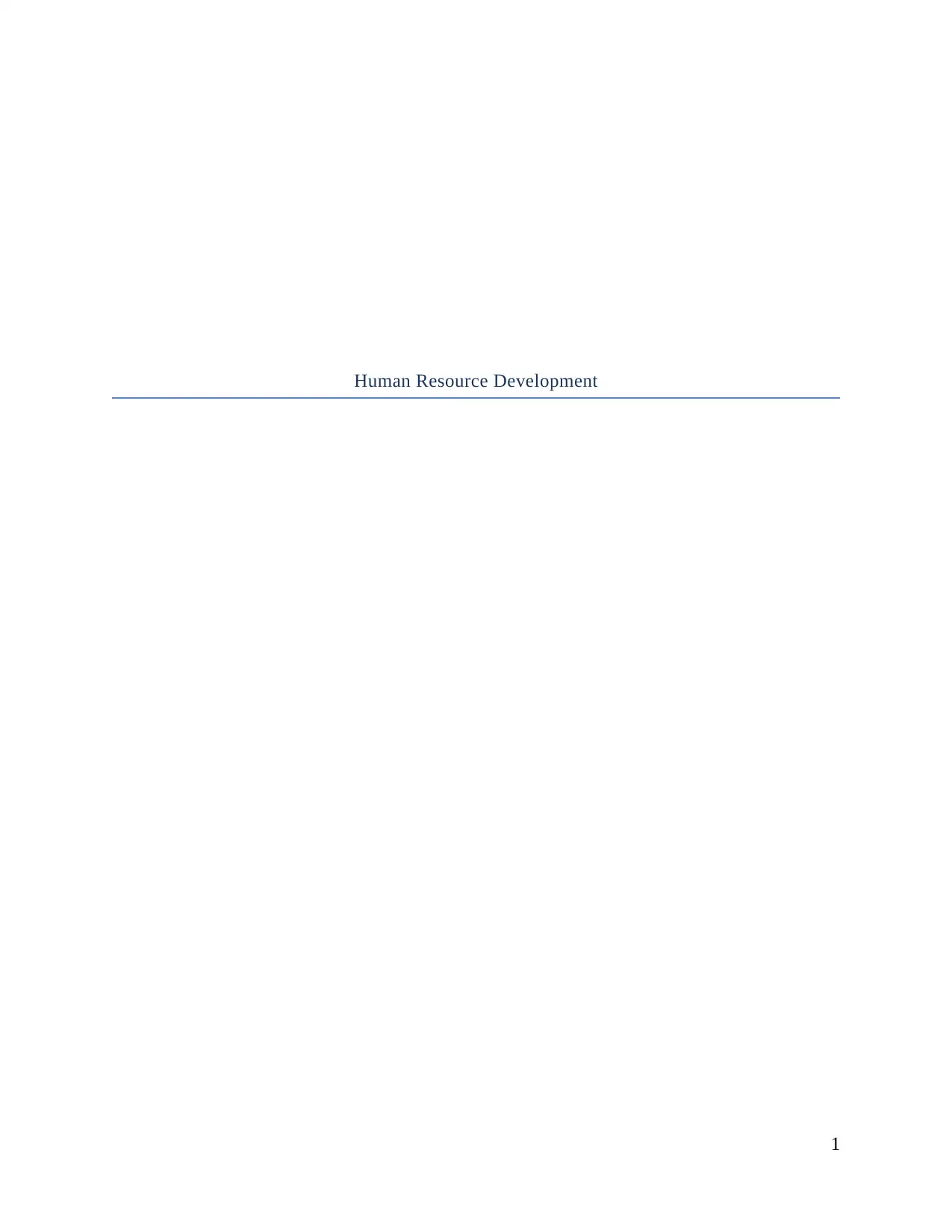
Human Resource Development
1
1
Secure Best Marks with AI Grader
Need help grading? Try our AI Grader for instant feedback on your assignments.
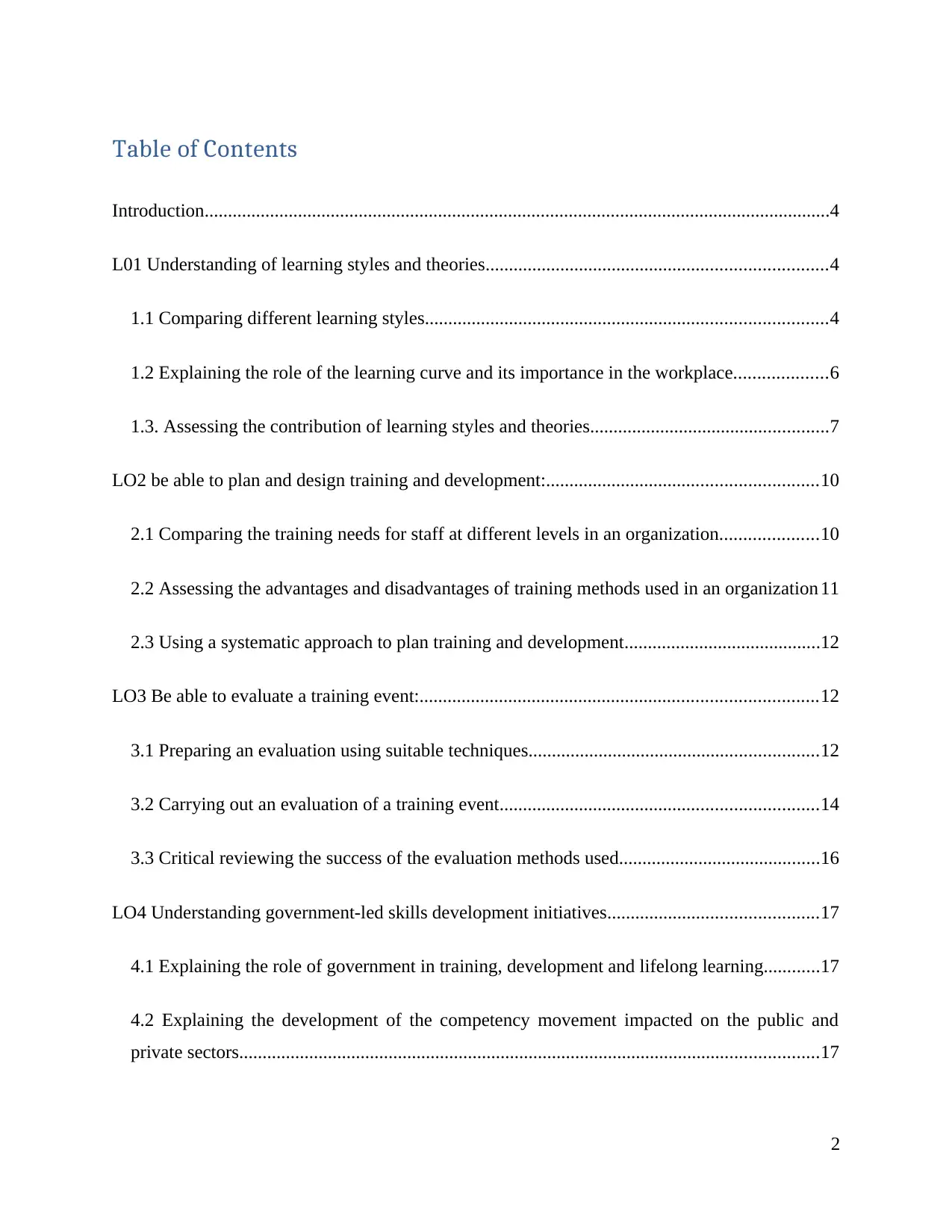
Table of Contents
Introduction......................................................................................................................................4
L01 Understanding of learning styles and theories.........................................................................4
1.1 Comparing different learning styles......................................................................................4
1.2 Explaining the role of the learning curve and its importance in the workplace....................6
1.3. Assessing the contribution of learning styles and theories...................................................7
LO2 be able to plan and design training and development:..........................................................10
2.1 Comparing the training needs for staff at different levels in an organization.....................10
2.2 Assessing the advantages and disadvantages of training methods used in an organization 11
2.3 Using a systematic approach to plan training and development..........................................12
LO3 Be able to evaluate a training event:.....................................................................................12
3.1 Preparing an evaluation using suitable techniques..............................................................12
3.2 Carrying out an evaluation of a training event....................................................................14
3.3 Critical reviewing the success of the evaluation methods used...........................................16
LO4 Understanding government-led skills development initiatives.............................................17
4.1 Explaining the role of government in training, development and lifelong learning............17
4.2 Explaining the development of the competency movement impacted on the public and
private sectors............................................................................................................................17
2
Introduction......................................................................................................................................4
L01 Understanding of learning styles and theories.........................................................................4
1.1 Comparing different learning styles......................................................................................4
1.2 Explaining the role of the learning curve and its importance in the workplace....................6
1.3. Assessing the contribution of learning styles and theories...................................................7
LO2 be able to plan and design training and development:..........................................................10
2.1 Comparing the training needs for staff at different levels in an organization.....................10
2.2 Assessing the advantages and disadvantages of training methods used in an organization 11
2.3 Using a systematic approach to plan training and development..........................................12
LO3 Be able to evaluate a training event:.....................................................................................12
3.1 Preparing an evaluation using suitable techniques..............................................................12
3.2 Carrying out an evaluation of a training event....................................................................14
3.3 Critical reviewing the success of the evaluation methods used...........................................16
LO4 Understanding government-led skills development initiatives.............................................17
4.1 Explaining the role of government in training, development and lifelong learning............17
4.2 Explaining the development of the competency movement impacted on the public and
private sectors............................................................................................................................17
2
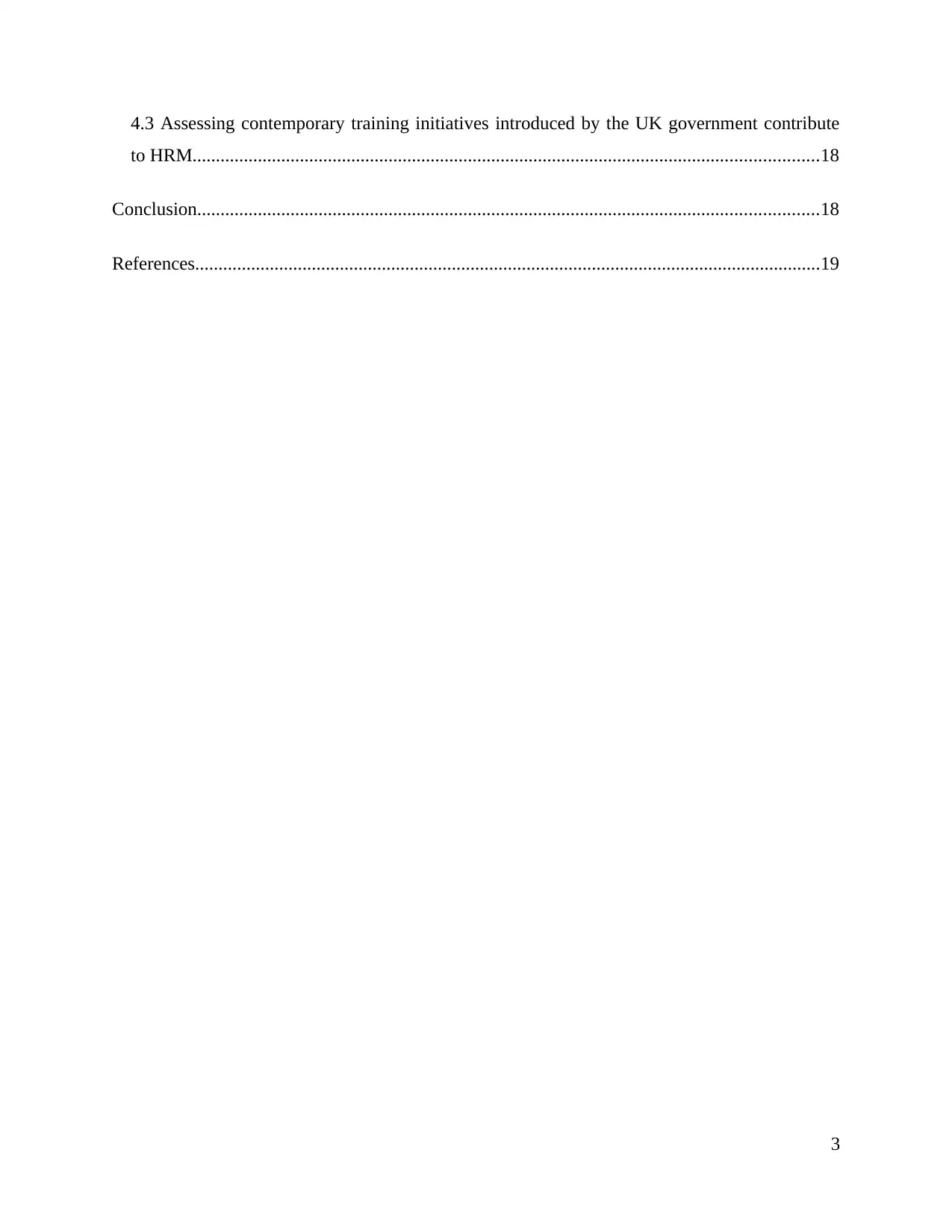
4.3 Assessing contemporary training initiatives introduced by the UK government contribute
to HRM......................................................................................................................................18
Conclusion.....................................................................................................................................18
References......................................................................................................................................19
3
to HRM......................................................................................................................................18
Conclusion.....................................................................................................................................18
References......................................................................................................................................19
3
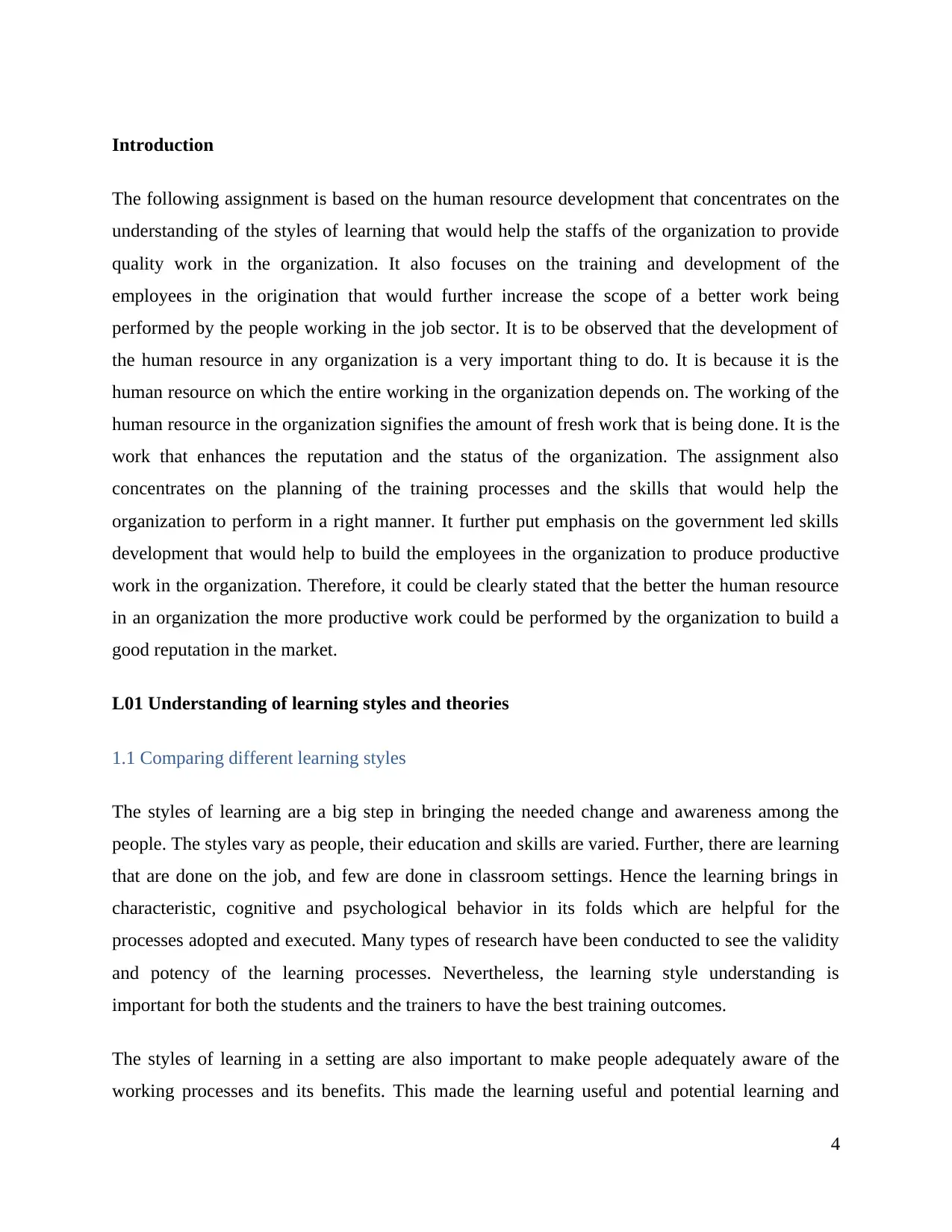
Introduction
The following assignment is based on the human resource development that concentrates on the
understanding of the styles of learning that would help the staffs of the organization to provide
quality work in the organization. It also focuses on the training and development of the
employees in the origination that would further increase the scope of a better work being
performed by the people working in the job sector. It is to be observed that the development of
the human resource in any organization is a very important thing to do. It is because it is the
human resource on which the entire working in the organization depends on. The working of the
human resource in the organization signifies the amount of fresh work that is being done. It is the
work that enhances the reputation and the status of the organization. The assignment also
concentrates on the planning of the training processes and the skills that would help the
organization to perform in a right manner. It further put emphasis on the government led skills
development that would help to build the employees in the organization to produce productive
work in the organization. Therefore, it could be clearly stated that the better the human resource
in an organization the more productive work could be performed by the organization to build a
good reputation in the market.
L01 Understanding of learning styles and theories
1.1 Comparing different learning styles
The styles of learning are a big step in bringing the needed change and awareness among the
people. The styles vary as people, their education and skills are varied. Further, there are learning
that are done on the job, and few are done in classroom settings. Hence the learning brings in
characteristic, cognitive and psychological behavior in its folds which are helpful for the
processes adopted and executed. Many types of research have been conducted to see the validity
and potency of the learning processes. Nevertheless, the learning style understanding is
important for both the students and the trainers to have the best training outcomes.
The styles of learning in a setting are also important to make people adequately aware of the
working processes and its benefits. This made the learning useful and potential learning and
4
The following assignment is based on the human resource development that concentrates on the
understanding of the styles of learning that would help the staffs of the organization to provide
quality work in the organization. It also focuses on the training and development of the
employees in the origination that would further increase the scope of a better work being
performed by the people working in the job sector. It is to be observed that the development of
the human resource in any organization is a very important thing to do. It is because it is the
human resource on which the entire working in the organization depends on. The working of the
human resource in the organization signifies the amount of fresh work that is being done. It is the
work that enhances the reputation and the status of the organization. The assignment also
concentrates on the planning of the training processes and the skills that would help the
organization to perform in a right manner. It further put emphasis on the government led skills
development that would help to build the employees in the organization to produce productive
work in the organization. Therefore, it could be clearly stated that the better the human resource
in an organization the more productive work could be performed by the organization to build a
good reputation in the market.
L01 Understanding of learning styles and theories
1.1 Comparing different learning styles
The styles of learning are a big step in bringing the needed change and awareness among the
people. The styles vary as people, their education and skills are varied. Further, there are learning
that are done on the job, and few are done in classroom settings. Hence the learning brings in
characteristic, cognitive and psychological behavior in its folds which are helpful for the
processes adopted and executed. Many types of research have been conducted to see the validity
and potency of the learning processes. Nevertheless, the learning style understanding is
important for both the students and the trainers to have the best training outcomes.
The styles of learning in a setting are also important to make people adequately aware of the
working processes and its benefits. This made the learning useful and potential learning and
4
Secure Best Marks with AI Grader
Need help grading? Try our AI Grader for instant feedback on your assignments.
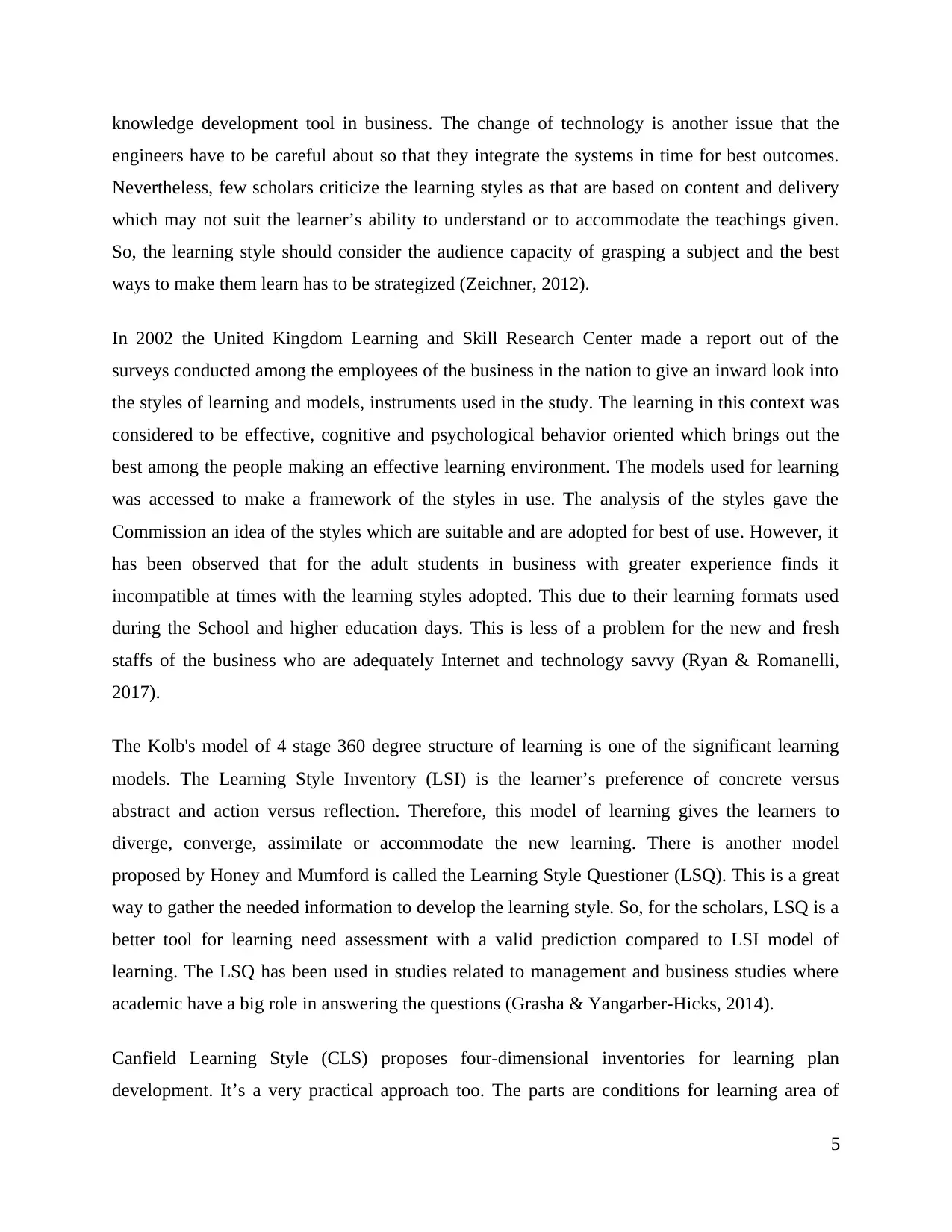
knowledge development tool in business. The change of technology is another issue that the
engineers have to be careful about so that they integrate the systems in time for best outcomes.
Nevertheless, few scholars criticize the learning styles as that are based on content and delivery
which may not suit the learner’s ability to understand or to accommodate the teachings given.
So, the learning style should consider the audience capacity of grasping a subject and the best
ways to make them learn has to be strategized (Zeichner, 2012).
In 2002 the United Kingdom Learning and Skill Research Center made a report out of the
surveys conducted among the employees of the business in the nation to give an inward look into
the styles of learning and models, instruments used in the study. The learning in this context was
considered to be effective, cognitive and psychological behavior oriented which brings out the
best among the people making an effective learning environment. The models used for learning
was accessed to make a framework of the styles in use. The analysis of the styles gave the
Commission an idea of the styles which are suitable and are adopted for best of use. However, it
has been observed that for the adult students in business with greater experience finds it
incompatible at times with the learning styles adopted. This due to their learning formats used
during the School and higher education days. This is less of a problem for the new and fresh
staffs of the business who are adequately Internet and technology savvy (Ryan & Romanelli,
2017).
The Kolb's model of 4 stage 360 degree structure of learning is one of the significant learning
models. The Learning Style Inventory (LSI) is the learner’s preference of concrete versus
abstract and action versus reflection. Therefore, this model of learning gives the learners to
diverge, converge, assimilate or accommodate the new learning. There is another model
proposed by Honey and Mumford is called the Learning Style Questioner (LSQ). This is a great
way to gather the needed information to develop the learning style. So, for the scholars, LSQ is a
better tool for learning need assessment with a valid prediction compared to LSI model of
learning. The LSQ has been used in studies related to management and business studies where
academic have a big role in answering the questions (Grasha & Yangarber-Hicks, 2014).
Canfield Learning Style (CLS) proposes four-dimensional inventories for learning plan
development. It’s a very practical approach too. The parts are conditions for learning area of
5
engineers have to be careful about so that they integrate the systems in time for best outcomes.
Nevertheless, few scholars criticize the learning styles as that are based on content and delivery
which may not suit the learner’s ability to understand or to accommodate the teachings given.
So, the learning style should consider the audience capacity of grasping a subject and the best
ways to make them learn has to be strategized (Zeichner, 2012).
In 2002 the United Kingdom Learning and Skill Research Center made a report out of the
surveys conducted among the employees of the business in the nation to give an inward look into
the styles of learning and models, instruments used in the study. The learning in this context was
considered to be effective, cognitive and psychological behavior oriented which brings out the
best among the people making an effective learning environment. The models used for learning
was accessed to make a framework of the styles in use. The analysis of the styles gave the
Commission an idea of the styles which are suitable and are adopted for best of use. However, it
has been observed that for the adult students in business with greater experience finds it
incompatible at times with the learning styles adopted. This due to their learning formats used
during the School and higher education days. This is less of a problem for the new and fresh
staffs of the business who are adequately Internet and technology savvy (Ryan & Romanelli,
2017).
The Kolb's model of 4 stage 360 degree structure of learning is one of the significant learning
models. The Learning Style Inventory (LSI) is the learner’s preference of concrete versus
abstract and action versus reflection. Therefore, this model of learning gives the learners to
diverge, converge, assimilate or accommodate the new learning. There is another model
proposed by Honey and Mumford is called the Learning Style Questioner (LSQ). This is a great
way to gather the needed information to develop the learning style. So, for the scholars, LSQ is a
better tool for learning need assessment with a valid prediction compared to LSI model of
learning. The LSQ has been used in studies related to management and business studies where
academic have a big role in answering the questions (Grasha & Yangarber-Hicks, 2014).
Canfield Learning Style (CLS) proposes four-dimensional inventories for learning plan
development. It’s a very practical approach too. The parts are conditions for learning area of
5
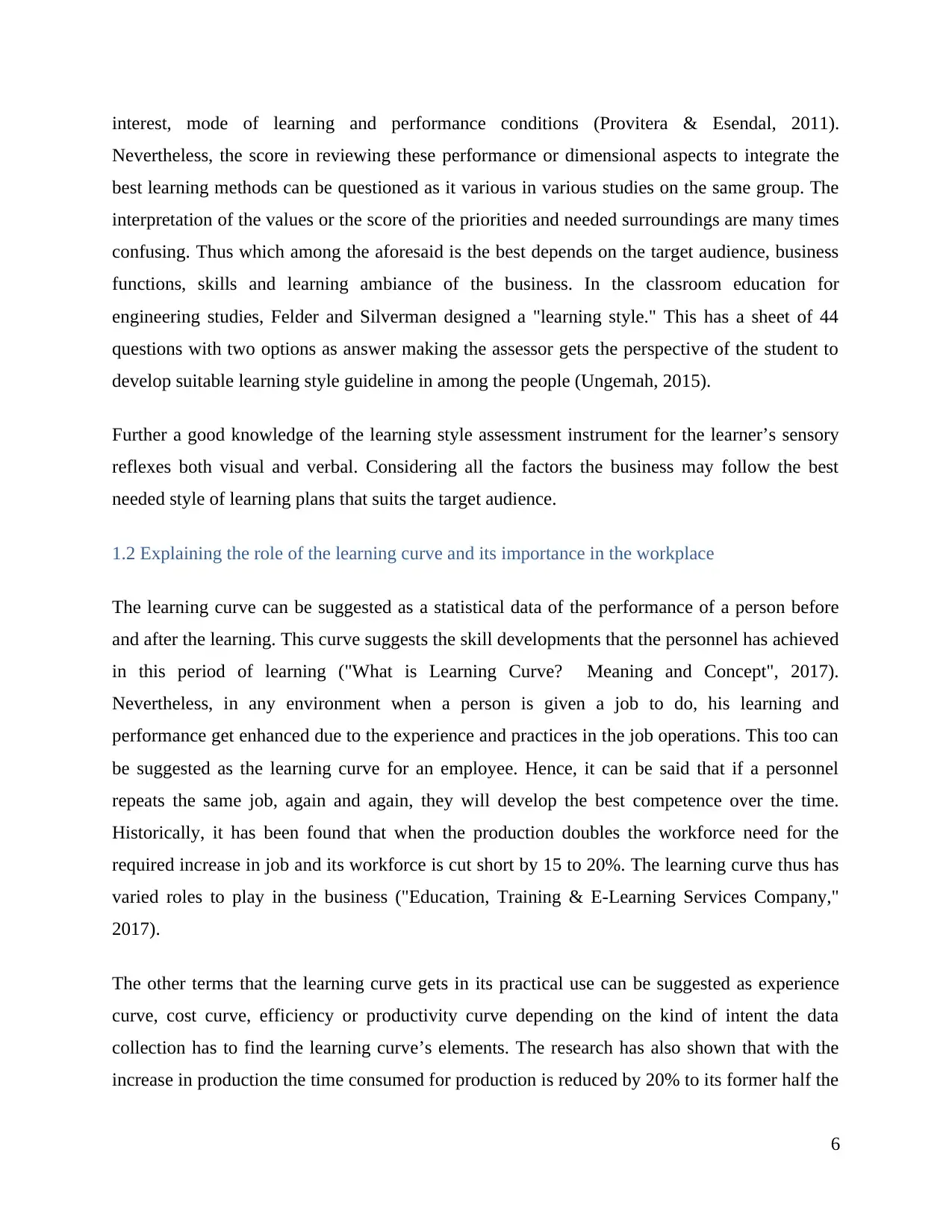
interest, mode of learning and performance conditions (Provitera & Esendal, 2011).
Nevertheless, the score in reviewing these performance or dimensional aspects to integrate the
best learning methods can be questioned as it various in various studies on the same group. The
interpretation of the values or the score of the priorities and needed surroundings are many times
confusing. Thus which among the aforesaid is the best depends on the target audience, business
functions, skills and learning ambiance of the business. In the classroom education for
engineering studies, Felder and Silverman designed a "learning style." This has a sheet of 44
questions with two options as answer making the assessor gets the perspective of the student to
develop suitable learning style guideline in among the people (Ungemah, 2015).
Further a good knowledge of the learning style assessment instrument for the learner’s sensory
reflexes both visual and verbal. Considering all the factors the business may follow the best
needed style of learning plans that suits the target audience.
1.2 Explaining the role of the learning curve and its importance in the workplace
The learning curve can be suggested as a statistical data of the performance of a person before
and after the learning. This curve suggests the skill developments that the personnel has achieved
in this period of learning ("What is Learning Curve? Meaning and Concept", 2017).
Nevertheless, in any environment when a person is given a job to do, his learning and
performance get enhanced due to the experience and practices in the job operations. This too can
be suggested as the learning curve for an employee. Hence, it can be said that if a personnel
repeats the same job, again and again, they will develop the best competence over the time.
Historically, it has been found that when the production doubles the workforce need for the
required increase in job and its workforce is cut short by 15 to 20%. The learning curve thus has
varied roles to play in the business ("Education, Training & E-Learning Services Company,"
2017).
The other terms that the learning curve gets in its practical use can be suggested as experience
curve, cost curve, efficiency or productivity curve depending on the kind of intent the data
collection has to find the learning curve’s elements. The research has also shown that with the
increase in production the time consumed for production is reduced by 20% to its former half the
6
Nevertheless, the score in reviewing these performance or dimensional aspects to integrate the
best learning methods can be questioned as it various in various studies on the same group. The
interpretation of the values or the score of the priorities and needed surroundings are many times
confusing. Thus which among the aforesaid is the best depends on the target audience, business
functions, skills and learning ambiance of the business. In the classroom education for
engineering studies, Felder and Silverman designed a "learning style." This has a sheet of 44
questions with two options as answer making the assessor gets the perspective of the student to
develop suitable learning style guideline in among the people (Ungemah, 2015).
Further a good knowledge of the learning style assessment instrument for the learner’s sensory
reflexes both visual and verbal. Considering all the factors the business may follow the best
needed style of learning plans that suits the target audience.
1.2 Explaining the role of the learning curve and its importance in the workplace
The learning curve can be suggested as a statistical data of the performance of a person before
and after the learning. This curve suggests the skill developments that the personnel has achieved
in this period of learning ("What is Learning Curve? Meaning and Concept", 2017).
Nevertheless, in any environment when a person is given a job to do, his learning and
performance get enhanced due to the experience and practices in the job operations. This too can
be suggested as the learning curve for an employee. Hence, it can be said that if a personnel
repeats the same job, again and again, they will develop the best competence over the time.
Historically, it has been found that when the production doubles the workforce need for the
required increase in job and its workforce is cut short by 15 to 20%. The learning curve thus has
varied roles to play in the business ("Education, Training & E-Learning Services Company,"
2017).
The other terms that the learning curve gets in its practical use can be suggested as experience
curve, cost curve, efficiency or productivity curve depending on the kind of intent the data
collection has to find the learning curve’s elements. The research has also shown that with the
increase in production the time consumed for production is reduced by 20% to its former half the
6
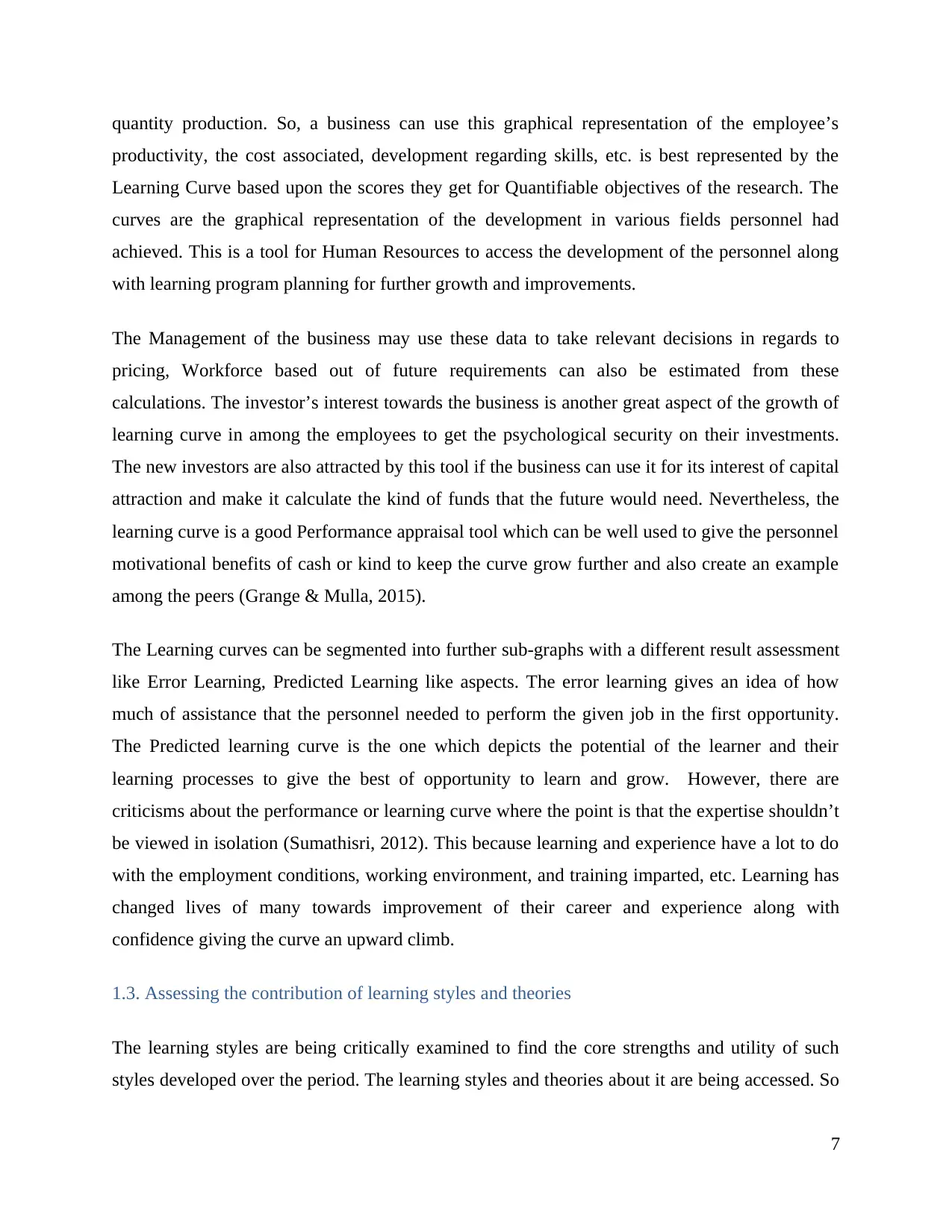
quantity production. So, a business can use this graphical representation of the employee’s
productivity, the cost associated, development regarding skills, etc. is best represented by the
Learning Curve based upon the scores they get for Quantifiable objectives of the research. The
curves are the graphical representation of the development in various fields personnel had
achieved. This is a tool for Human Resources to access the development of the personnel along
with learning program planning for further growth and improvements.
The Management of the business may use these data to take relevant decisions in regards to
pricing, Workforce based out of future requirements can also be estimated from these
calculations. The investor’s interest towards the business is another great aspect of the growth of
learning curve in among the employees to get the psychological security on their investments.
The new investors are also attracted by this tool if the business can use it for its interest of capital
attraction and make it calculate the kind of funds that the future would need. Nevertheless, the
learning curve is a good Performance appraisal tool which can be well used to give the personnel
motivational benefits of cash or kind to keep the curve grow further and also create an example
among the peers (Grange & Mulla, 2015).
The Learning curves can be segmented into further sub-graphs with a different result assessment
like Error Learning, Predicted Learning like aspects. The error learning gives an idea of how
much of assistance that the personnel needed to perform the given job in the first opportunity.
The Predicted learning curve is the one which depicts the potential of the learner and their
learning processes to give the best of opportunity to learn and grow. However, there are
criticisms about the performance or learning curve where the point is that the expertise shouldn’t
be viewed in isolation (Sumathisri, 2012). This because learning and experience have a lot to do
with the employment conditions, working environment, and training imparted, etc. Learning has
changed lives of many towards improvement of their career and experience along with
confidence giving the curve an upward climb.
1.3. Assessing the contribution of learning styles and theories
The learning styles are being critically examined to find the core strengths and utility of such
styles developed over the period. The learning styles and theories about it are being accessed. So
7
productivity, the cost associated, development regarding skills, etc. is best represented by the
Learning Curve based upon the scores they get for Quantifiable objectives of the research. The
curves are the graphical representation of the development in various fields personnel had
achieved. This is a tool for Human Resources to access the development of the personnel along
with learning program planning for further growth and improvements.
The Management of the business may use these data to take relevant decisions in regards to
pricing, Workforce based out of future requirements can also be estimated from these
calculations. The investor’s interest towards the business is another great aspect of the growth of
learning curve in among the employees to get the psychological security on their investments.
The new investors are also attracted by this tool if the business can use it for its interest of capital
attraction and make it calculate the kind of funds that the future would need. Nevertheless, the
learning curve is a good Performance appraisal tool which can be well used to give the personnel
motivational benefits of cash or kind to keep the curve grow further and also create an example
among the peers (Grange & Mulla, 2015).
The Learning curves can be segmented into further sub-graphs with a different result assessment
like Error Learning, Predicted Learning like aspects. The error learning gives an idea of how
much of assistance that the personnel needed to perform the given job in the first opportunity.
The Predicted learning curve is the one which depicts the potential of the learner and their
learning processes to give the best of opportunity to learn and grow. However, there are
criticisms about the performance or learning curve where the point is that the expertise shouldn’t
be viewed in isolation (Sumathisri, 2012). This because learning and experience have a lot to do
with the employment conditions, working environment, and training imparted, etc. Learning has
changed lives of many towards improvement of their career and experience along with
confidence giving the curve an upward climb.
1.3. Assessing the contribution of learning styles and theories
The learning styles are being critically examined to find the core strengths and utility of such
styles developed over the period. The learning styles and theories about it are being accessed. So
7
Paraphrase This Document
Need a fresh take? Get an instant paraphrase of this document with our AI Paraphraser
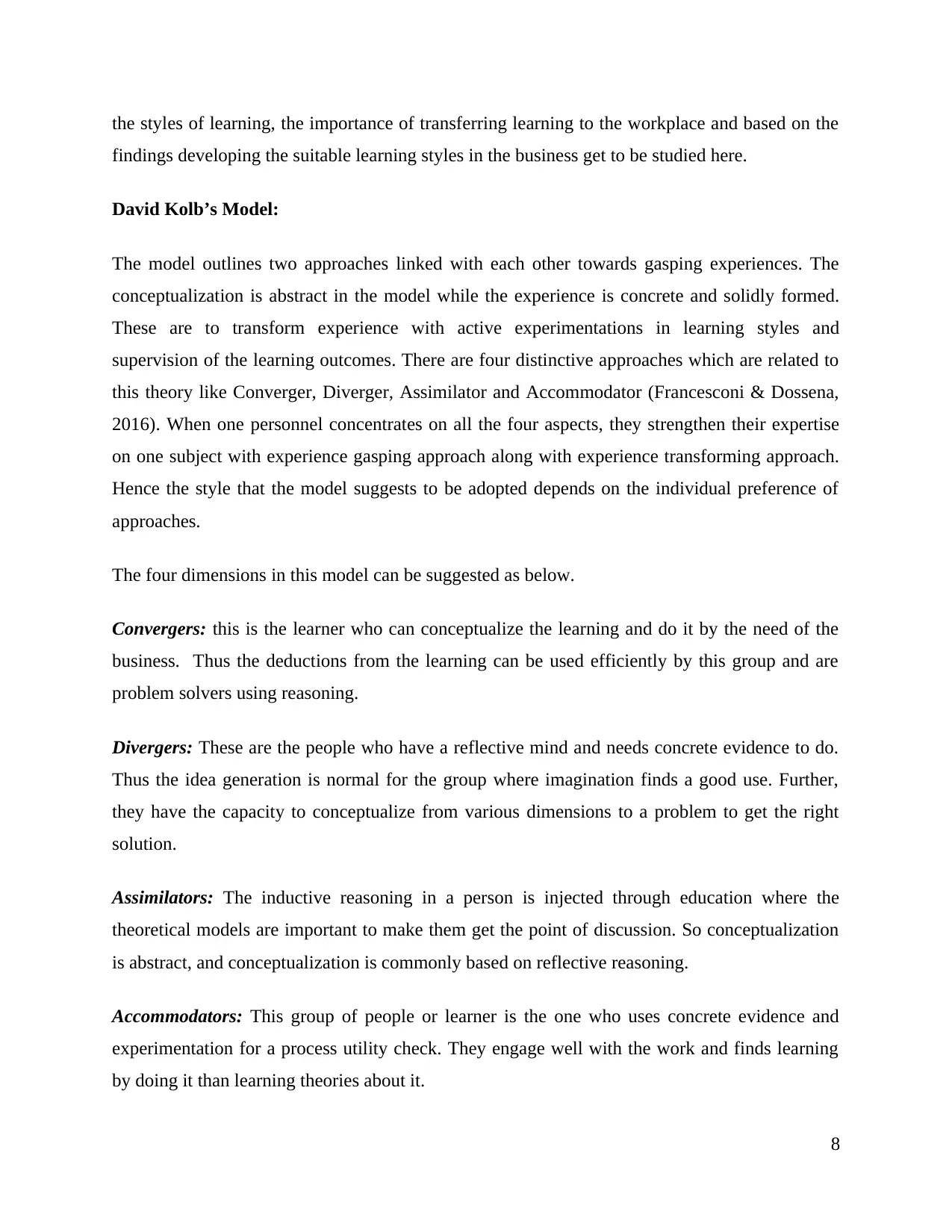
the styles of learning, the importance of transferring learning to the workplace and based on the
findings developing the suitable learning styles in the business get to be studied here.
David Kolb’s Model:
The model outlines two approaches linked with each other towards gasping experiences. The
conceptualization is abstract in the model while the experience is concrete and solidly formed.
These are to transform experience with active experimentations in learning styles and
supervision of the learning outcomes. There are four distinctive approaches which are related to
this theory like Converger, Diverger, Assimilator and Accommodator (Francesconi & Dossena,
2016). When one personnel concentrates on all the four aspects, they strengthen their expertise
on one subject with experience gasping approach along with experience transforming approach.
Hence the style that the model suggests to be adopted depends on the individual preference of
approaches.
The four dimensions in this model can be suggested as below.
Convergers: this is the learner who can conceptualize the learning and do it by the need of the
business. Thus the deductions from the learning can be used efficiently by this group and are
problem solvers using reasoning.
Divergers: These are the people who have a reflective mind and needs concrete evidence to do.
Thus the idea generation is normal for the group where imagination finds a good use. Further,
they have the capacity to conceptualize from various dimensions to a problem to get the right
solution.
Assimilators: The inductive reasoning in a person is injected through education where the
theoretical models are important to make them get the point of discussion. So conceptualization
is abstract, and conceptualization is commonly based on reflective reasoning.
Accommodators: This group of people or learner is the one who uses concrete evidence and
experimentation for a process utility check. They engage well with the work and finds learning
by doing it than learning theories about it.
8
findings developing the suitable learning styles in the business get to be studied here.
David Kolb’s Model:
The model outlines two approaches linked with each other towards gasping experiences. The
conceptualization is abstract in the model while the experience is concrete and solidly formed.
These are to transform experience with active experimentations in learning styles and
supervision of the learning outcomes. There are four distinctive approaches which are related to
this theory like Converger, Diverger, Assimilator and Accommodator (Francesconi & Dossena,
2016). When one personnel concentrates on all the four aspects, they strengthen their expertise
on one subject with experience gasping approach along with experience transforming approach.
Hence the style that the model suggests to be adopted depends on the individual preference of
approaches.
The four dimensions in this model can be suggested as below.
Convergers: this is the learner who can conceptualize the learning and do it by the need of the
business. Thus the deductions from the learning can be used efficiently by this group and are
problem solvers using reasoning.
Divergers: These are the people who have a reflective mind and needs concrete evidence to do.
Thus the idea generation is normal for the group where imagination finds a good use. Further,
they have the capacity to conceptualize from various dimensions to a problem to get the right
solution.
Assimilators: The inductive reasoning in a person is injected through education where the
theoretical models are important to make them get the point of discussion. So conceptualization
is abstract, and conceptualization is commonly based on reflective reasoning.
Accommodators: This group of people or learner is the one who uses concrete evidence and
experimentation for a process utility check. They engage well with the work and finds learning
by doing it than learning theories about it.
8
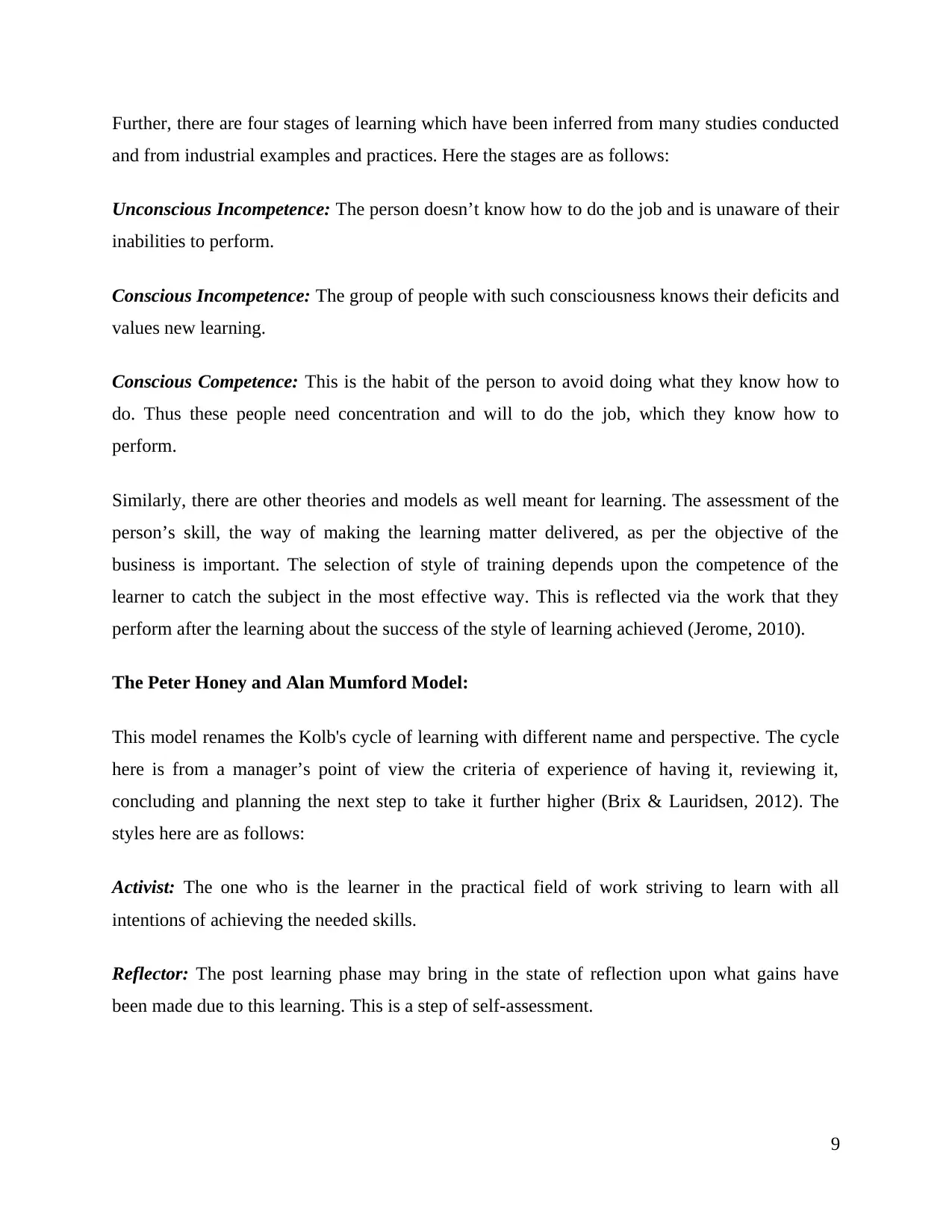
Further, there are four stages of learning which have been inferred from many studies conducted
and from industrial examples and practices. Here the stages are as follows:
Unconscious Incompetence: The person doesn’t know how to do the job and is unaware of their
inabilities to perform.
Conscious Incompetence: The group of people with such consciousness knows their deficits and
values new learning.
Conscious Competence: This is the habit of the person to avoid doing what they know how to
do. Thus these people need concentration and will to do the job, which they know how to
perform.
Similarly, there are other theories and models as well meant for learning. The assessment of the
person’s skill, the way of making the learning matter delivered, as per the objective of the
business is important. The selection of style of training depends upon the competence of the
learner to catch the subject in the most effective way. This is reflected via the work that they
perform after the learning about the success of the style of learning achieved (Jerome, 2010).
The Peter Honey and Alan Mumford Model:
This model renames the Kolb's cycle of learning with different name and perspective. The cycle
here is from a manager’s point of view the criteria of experience of having it, reviewing it,
concluding and planning the next step to take it further higher (Brix & Lauridsen, 2012). The
styles here are as follows:
Activist: The one who is the learner in the practical field of work striving to learn with all
intentions of achieving the needed skills.
Reflector: The post learning phase may bring in the state of reflection upon what gains have
been made due to this learning. This is a step of self-assessment.
9
and from industrial examples and practices. Here the stages are as follows:
Unconscious Incompetence: The person doesn’t know how to do the job and is unaware of their
inabilities to perform.
Conscious Incompetence: The group of people with such consciousness knows their deficits and
values new learning.
Conscious Competence: This is the habit of the person to avoid doing what they know how to
do. Thus these people need concentration and will to do the job, which they know how to
perform.
Similarly, there are other theories and models as well meant for learning. The assessment of the
person’s skill, the way of making the learning matter delivered, as per the objective of the
business is important. The selection of style of training depends upon the competence of the
learner to catch the subject in the most effective way. This is reflected via the work that they
perform after the learning about the success of the style of learning achieved (Jerome, 2010).
The Peter Honey and Alan Mumford Model:
This model renames the Kolb's cycle of learning with different name and perspective. The cycle
here is from a manager’s point of view the criteria of experience of having it, reviewing it,
concluding and planning the next step to take it further higher (Brix & Lauridsen, 2012). The
styles here are as follows:
Activist: The one who is the learner in the practical field of work striving to learn with all
intentions of achieving the needed skills.
Reflector: The post learning phase may bring in the state of reflection upon what gains have
been made due to this learning. This is a step of self-assessment.
9
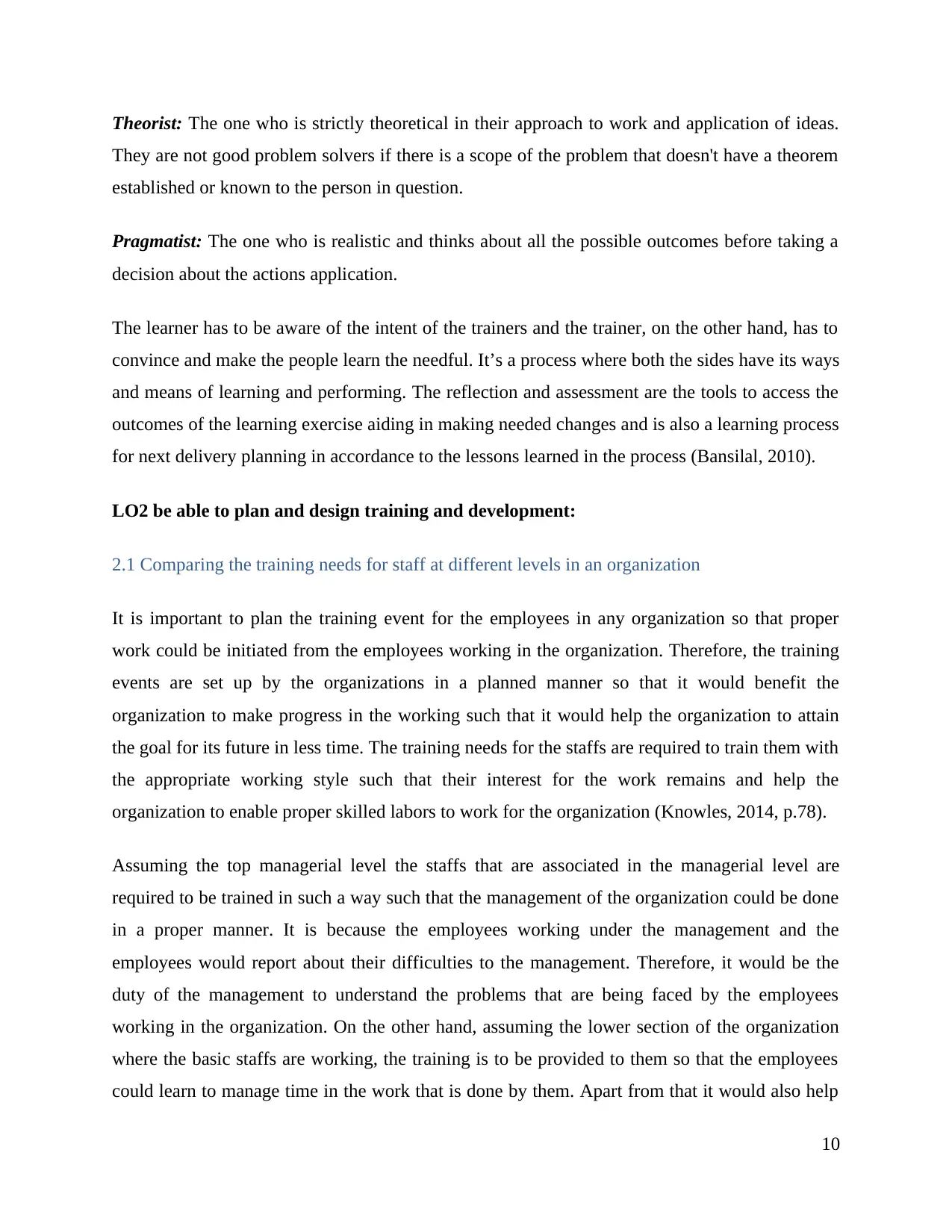
Theorist: The one who is strictly theoretical in their approach to work and application of ideas.
They are not good problem solvers if there is a scope of the problem that doesn't have a theorem
established or known to the person in question.
Pragmatist: The one who is realistic and thinks about all the possible outcomes before taking a
decision about the actions application.
The learner has to be aware of the intent of the trainers and the trainer, on the other hand, has to
convince and make the people learn the needful. It’s a process where both the sides have its ways
and means of learning and performing. The reflection and assessment are the tools to access the
outcomes of the learning exercise aiding in making needed changes and is also a learning process
for next delivery planning in accordance to the lessons learned in the process (Bansilal, 2010).
LO2 be able to plan and design training and development:
2.1 Comparing the training needs for staff at different levels in an organization
It is important to plan the training event for the employees in any organization so that proper
work could be initiated from the employees working in the organization. Therefore, the training
events are set up by the organizations in a planned manner so that it would benefit the
organization to make progress in the working such that it would help the organization to attain
the goal for its future in less time. The training needs for the staffs are required to train them with
the appropriate working style such that their interest for the work remains and help the
organization to enable proper skilled labors to work for the organization (Knowles, 2014, p.78).
Assuming the top managerial level the staffs that are associated in the managerial level are
required to be trained in such a way such that the management of the organization could be done
in a proper manner. It is because the employees working under the management and the
employees would report about their difficulties to the management. Therefore, it would be the
duty of the management to understand the problems that are being faced by the employees
working in the organization. On the other hand, assuming the lower section of the organization
where the basic staffs are working, the training is to be provided to them so that the employees
could learn to manage time in the work that is done by them. Apart from that it would also help
10
They are not good problem solvers if there is a scope of the problem that doesn't have a theorem
established or known to the person in question.
Pragmatist: The one who is realistic and thinks about all the possible outcomes before taking a
decision about the actions application.
The learner has to be aware of the intent of the trainers and the trainer, on the other hand, has to
convince and make the people learn the needful. It’s a process where both the sides have its ways
and means of learning and performing. The reflection and assessment are the tools to access the
outcomes of the learning exercise aiding in making needed changes and is also a learning process
for next delivery planning in accordance to the lessons learned in the process (Bansilal, 2010).
LO2 be able to plan and design training and development:
2.1 Comparing the training needs for staff at different levels in an organization
It is important to plan the training event for the employees in any organization so that proper
work could be initiated from the employees working in the organization. Therefore, the training
events are set up by the organizations in a planned manner so that it would benefit the
organization to make progress in the working such that it would help the organization to attain
the goal for its future in less time. The training needs for the staffs are required to train them with
the appropriate working style such that their interest for the work remains and help the
organization to enable proper skilled labors to work for the organization (Knowles, 2014, p.78).
Assuming the top managerial level the staffs that are associated in the managerial level are
required to be trained in such a way such that the management of the organization could be done
in a proper manner. It is because the employees working under the management and the
employees would report about their difficulties to the management. Therefore, it would be the
duty of the management to understand the problems that are being faced by the employees
working in the organization. On the other hand, assuming the lower section of the organization
where the basic staffs are working, the training is to be provided to them so that the employees
could learn to manage time in the work that is done by them. Apart from that it would also help
10
Secure Best Marks with AI Grader
Need help grading? Try our AI Grader for instant feedback on your assignments.
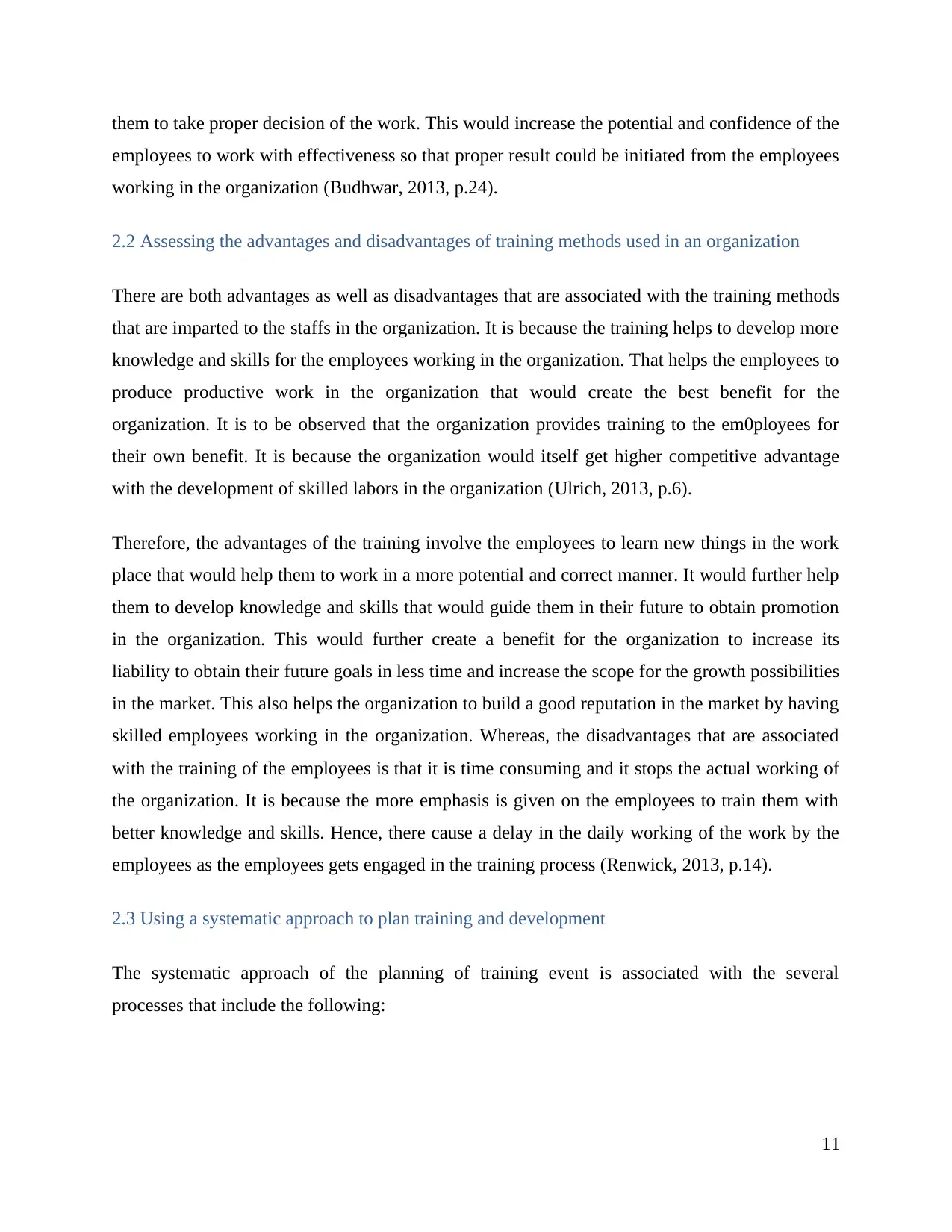
them to take proper decision of the work. This would increase the potential and confidence of the
employees to work with effectiveness so that proper result could be initiated from the employees
working in the organization (Budhwar, 2013, p.24).
2.2 Assessing the advantages and disadvantages of training methods used in an organization
There are both advantages as well as disadvantages that are associated with the training methods
that are imparted to the staffs in the organization. It is because the training helps to develop more
knowledge and skills for the employees working in the organization. That helps the employees to
produce productive work in the organization that would create the best benefit for the
organization. It is to be observed that the organization provides training to the em0ployees for
their own benefit. It is because the organization would itself get higher competitive advantage
with the development of skilled labors in the organization (Ulrich, 2013, p.6).
Therefore, the advantages of the training involve the employees to learn new things in the work
place that would help them to work in a more potential and correct manner. It would further help
them to develop knowledge and skills that would guide them in their future to obtain promotion
in the organization. This would further create a benefit for the organization to increase its
liability to obtain their future goals in less time and increase the scope for the growth possibilities
in the market. This also helps the organization to build a good reputation in the market by having
skilled employees working in the organization. Whereas, the disadvantages that are associated
with the training of the employees is that it is time consuming and it stops the actual working of
the organization. It is because the more emphasis is given on the employees to train them with
better knowledge and skills. Hence, there cause a delay in the daily working of the work by the
employees as the employees gets engaged in the training process (Renwick, 2013, p.14).
2.3 Using a systematic approach to plan training and development
The systematic approach of the planning of training event is associated with the several
processes that include the following:
11
employees to work with effectiveness so that proper result could be initiated from the employees
working in the organization (Budhwar, 2013, p.24).
2.2 Assessing the advantages and disadvantages of training methods used in an organization
There are both advantages as well as disadvantages that are associated with the training methods
that are imparted to the staffs in the organization. It is because the training helps to develop more
knowledge and skills for the employees working in the organization. That helps the employees to
produce productive work in the organization that would create the best benefit for the
organization. It is to be observed that the organization provides training to the em0ployees for
their own benefit. It is because the organization would itself get higher competitive advantage
with the development of skilled labors in the organization (Ulrich, 2013, p.6).
Therefore, the advantages of the training involve the employees to learn new things in the work
place that would help them to work in a more potential and correct manner. It would further help
them to develop knowledge and skills that would guide them in their future to obtain promotion
in the organization. This would further create a benefit for the organization to increase its
liability to obtain their future goals in less time and increase the scope for the growth possibilities
in the market. This also helps the organization to build a good reputation in the market by having
skilled employees working in the organization. Whereas, the disadvantages that are associated
with the training of the employees is that it is time consuming and it stops the actual working of
the organization. It is because the more emphasis is given on the employees to train them with
better knowledge and skills. Hence, there cause a delay in the daily working of the work by the
employees as the employees gets engaged in the training process (Renwick, 2013, p.14).
2.3 Using a systematic approach to plan training and development
The systematic approach of the planning of training event is associated with the several
processes that include the following:
11
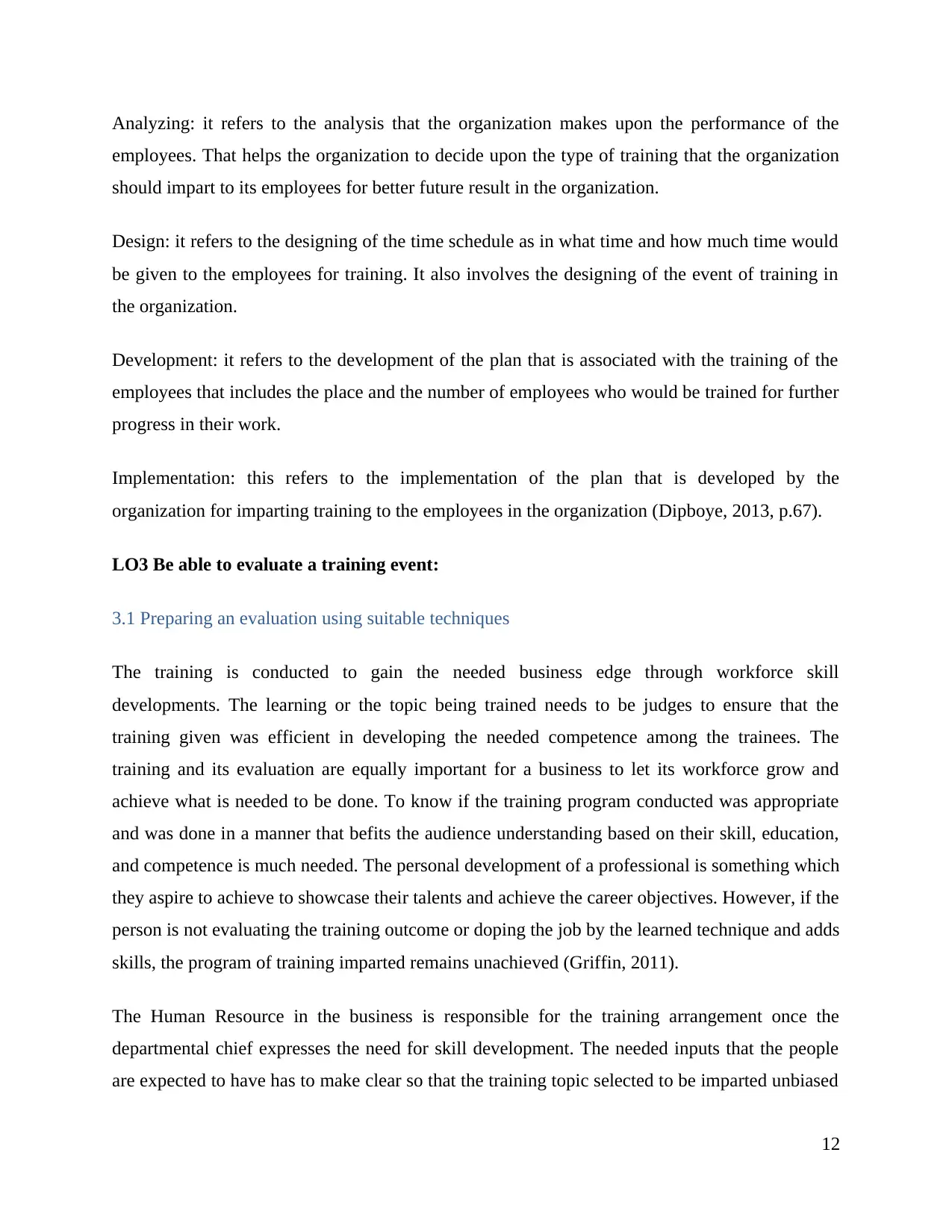
Analyzing: it refers to the analysis that the organization makes upon the performance of the
employees. That helps the organization to decide upon the type of training that the organization
should impart to its employees for better future result in the organization.
Design: it refers to the designing of the time schedule as in what time and how much time would
be given to the employees for training. It also involves the designing of the event of training in
the organization.
Development: it refers to the development of the plan that is associated with the training of the
employees that includes the place and the number of employees who would be trained for further
progress in their work.
Implementation: this refers to the implementation of the plan that is developed by the
organization for imparting training to the employees in the organization (Dipboye, 2013, p.67).
LO3 Be able to evaluate a training event:
3.1 Preparing an evaluation using suitable techniques
The training is conducted to gain the needed business edge through workforce skill
developments. The learning or the topic being trained needs to be judges to ensure that the
training given was efficient in developing the needed competence among the trainees. The
training and its evaluation are equally important for a business to let its workforce grow and
achieve what is needed to be done. To know if the training program conducted was appropriate
and was done in a manner that befits the audience understanding based on their skill, education,
and competence is much needed. The personal development of a professional is something which
they aspire to achieve to showcase their talents and achieve the career objectives. However, if the
person is not evaluating the training outcome or doping the job by the learned technique and adds
skills, the program of training imparted remains unachieved (Griffin, 2011).
The Human Resource in the business is responsible for the training arrangement once the
departmental chief expresses the need for skill development. The needed inputs that the people
are expected to have has to make clear so that the training topic selected to be imparted unbiased
12
employees. That helps the organization to decide upon the type of training that the organization
should impart to its employees for better future result in the organization.
Design: it refers to the designing of the time schedule as in what time and how much time would
be given to the employees for training. It also involves the designing of the event of training in
the organization.
Development: it refers to the development of the plan that is associated with the training of the
employees that includes the place and the number of employees who would be trained for further
progress in their work.
Implementation: this refers to the implementation of the plan that is developed by the
organization for imparting training to the employees in the organization (Dipboye, 2013, p.67).
LO3 Be able to evaluate a training event:
3.1 Preparing an evaluation using suitable techniques
The training is conducted to gain the needed business edge through workforce skill
developments. The learning or the topic being trained needs to be judges to ensure that the
training given was efficient in developing the needed competence among the trainees. The
training and its evaluation are equally important for a business to let its workforce grow and
achieve what is needed to be done. To know if the training program conducted was appropriate
and was done in a manner that befits the audience understanding based on their skill, education,
and competence is much needed. The personal development of a professional is something which
they aspire to achieve to showcase their talents and achieve the career objectives. However, if the
person is not evaluating the training outcome or doping the job by the learned technique and adds
skills, the program of training imparted remains unachieved (Griffin, 2011).
The Human Resource in the business is responsible for the training arrangement once the
departmental chief expresses the need for skill development. The needed inputs that the people
are expected to have has to make clear so that the training topic selected to be imparted unbiased
12
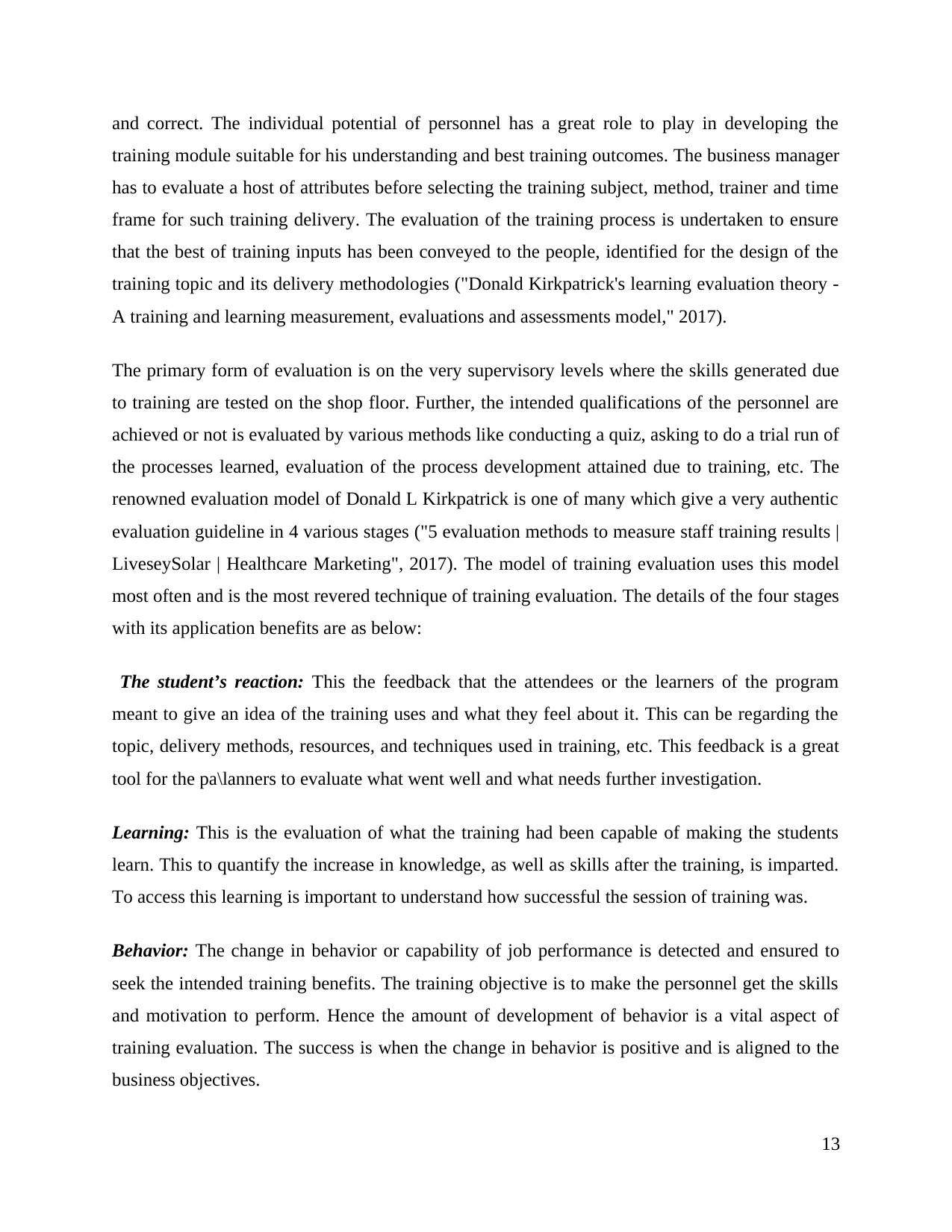
and correct. The individual potential of personnel has a great role to play in developing the
training module suitable for his understanding and best training outcomes. The business manager
has to evaluate a host of attributes before selecting the training subject, method, trainer and time
frame for such training delivery. The evaluation of the training process is undertaken to ensure
that the best of training inputs has been conveyed to the people, identified for the design of the
training topic and its delivery methodologies ("Donald Kirkpatrick's learning evaluation theory -
A training and learning measurement, evaluations and assessments model," 2017).
The primary form of evaluation is on the very supervisory levels where the skills generated due
to training are tested on the shop floor. Further, the intended qualifications of the personnel are
achieved or not is evaluated by various methods like conducting a quiz, asking to do a trial run of
the processes learned, evaluation of the process development attained due to training, etc. The
renowned evaluation model of Donald L Kirkpatrick is one of many which give a very authentic
evaluation guideline in 4 various stages ("5 evaluation methods to measure staff training results |
LiveseySolar | Healthcare Marketing", 2017). The model of training evaluation uses this model
most often and is the most revered technique of training evaluation. The details of the four stages
with its application benefits are as below:
The student’s reaction: This the feedback that the attendees or the learners of the program
meant to give an idea of the training uses and what they feel about it. This can be regarding the
topic, delivery methods, resources, and techniques used in training, etc. This feedback is a great
tool for the pa\lanners to evaluate what went well and what needs further investigation.
Learning: This is the evaluation of what the training had been capable of making the students
learn. This to quantify the increase in knowledge, as well as skills after the training, is imparted.
To access this learning is important to understand how successful the session of training was.
Behavior: The change in behavior or capability of job performance is detected and ensured to
seek the intended training benefits. The training objective is to make the personnel get the skills
and motivation to perform. Hence the amount of development of behavior is a vital aspect of
training evaluation. The success is when the change in behavior is positive and is aligned to the
business objectives.
13
training module suitable for his understanding and best training outcomes. The business manager
has to evaluate a host of attributes before selecting the training subject, method, trainer and time
frame for such training delivery. The evaluation of the training process is undertaken to ensure
that the best of training inputs has been conveyed to the people, identified for the design of the
training topic and its delivery methodologies ("Donald Kirkpatrick's learning evaluation theory -
A training and learning measurement, evaluations and assessments model," 2017).
The primary form of evaluation is on the very supervisory levels where the skills generated due
to training are tested on the shop floor. Further, the intended qualifications of the personnel are
achieved or not is evaluated by various methods like conducting a quiz, asking to do a trial run of
the processes learned, evaluation of the process development attained due to training, etc. The
renowned evaluation model of Donald L Kirkpatrick is one of many which give a very authentic
evaluation guideline in 4 various stages ("5 evaluation methods to measure staff training results |
LiveseySolar | Healthcare Marketing", 2017). The model of training evaluation uses this model
most often and is the most revered technique of training evaluation. The details of the four stages
with its application benefits are as below:
The student’s reaction: This the feedback that the attendees or the learners of the program
meant to give an idea of the training uses and what they feel about it. This can be regarding the
topic, delivery methods, resources, and techniques used in training, etc. This feedback is a great
tool for the pa\lanners to evaluate what went well and what needs further investigation.
Learning: This is the evaluation of what the training had been capable of making the students
learn. This to quantify the increase in knowledge, as well as skills after the training, is imparted.
To access this learning is important to understand how successful the session of training was.
Behavior: The change in behavior or capability of job performance is detected and ensured to
seek the intended training benefits. The training objective is to make the personnel get the skills
and motivation to perform. Hence the amount of development of behavior is a vital aspect of
training evaluation. The success is when the change in behavior is positive and is aligned to the
business objectives.
13
Paraphrase This Document
Need a fresh take? Get an instant paraphrase of this document with our AI Paraphraser
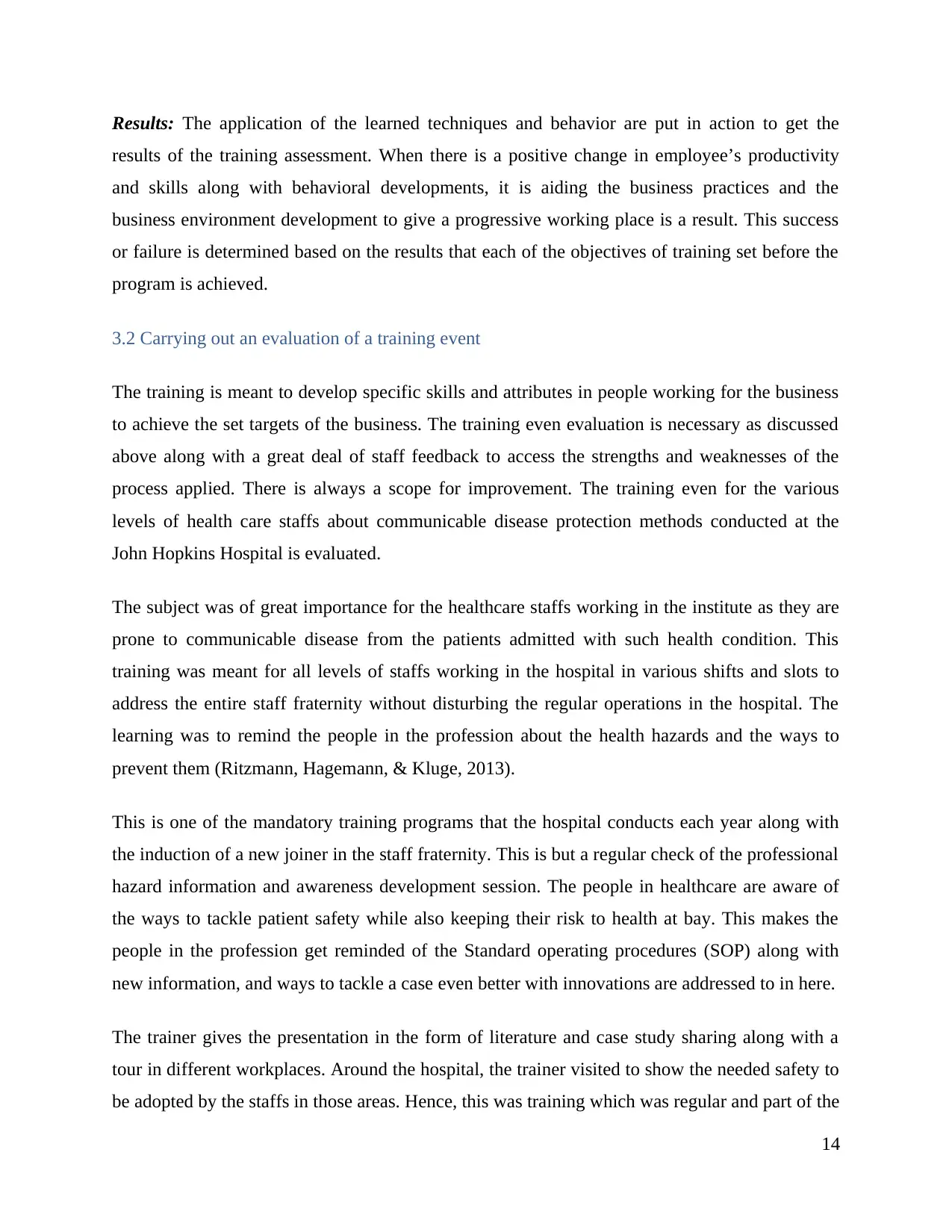
Results: The application of the learned techniques and behavior are put in action to get the
results of the training assessment. When there is a positive change in employee’s productivity
and skills along with behavioral developments, it is aiding the business practices and the
business environment development to give a progressive working place is a result. This success
or failure is determined based on the results that each of the objectives of training set before the
program is achieved.
3.2 Carrying out an evaluation of a training event
The training is meant to develop specific skills and attributes in people working for the business
to achieve the set targets of the business. The training even evaluation is necessary as discussed
above along with a great deal of staff feedback to access the strengths and weaknesses of the
process applied. There is always a scope for improvement. The training even for the various
levels of health care staffs about communicable disease protection methods conducted at the
John Hopkins Hospital is evaluated.
The subject was of great importance for the healthcare staffs working in the institute as they are
prone to communicable disease from the patients admitted with such health condition. This
training was meant for all levels of staffs working in the hospital in various shifts and slots to
address the entire staff fraternity without disturbing the regular operations in the hospital. The
learning was to remind the people in the profession about the health hazards and the ways to
prevent them (Ritzmann, Hagemann, & Kluge, 2013).
This is one of the mandatory training programs that the hospital conducts each year along with
the induction of a new joiner in the staff fraternity. This is but a regular check of the professional
hazard information and awareness development session. The people in healthcare are aware of
the ways to tackle patient safety while also keeping their risk to health at bay. This makes the
people in the profession get reminded of the Standard operating procedures (SOP) along with
new information, and ways to tackle a case even better with innovations are addressed to in here.
The trainer gives the presentation in the form of literature and case study sharing along with a
tour in different workplaces. Around the hospital, the trainer visited to show the needed safety to
be adopted by the staffs in those areas. Hence, this was training which was regular and part of the
14
results of the training assessment. When there is a positive change in employee’s productivity
and skills along with behavioral developments, it is aiding the business practices and the
business environment development to give a progressive working place is a result. This success
or failure is determined based on the results that each of the objectives of training set before the
program is achieved.
3.2 Carrying out an evaluation of a training event
The training is meant to develop specific skills and attributes in people working for the business
to achieve the set targets of the business. The training even evaluation is necessary as discussed
above along with a great deal of staff feedback to access the strengths and weaknesses of the
process applied. There is always a scope for improvement. The training even for the various
levels of health care staffs about communicable disease protection methods conducted at the
John Hopkins Hospital is evaluated.
The subject was of great importance for the healthcare staffs working in the institute as they are
prone to communicable disease from the patients admitted with such health condition. This
training was meant for all levels of staffs working in the hospital in various shifts and slots to
address the entire staff fraternity without disturbing the regular operations in the hospital. The
learning was to remind the people in the profession about the health hazards and the ways to
prevent them (Ritzmann, Hagemann, & Kluge, 2013).
This is one of the mandatory training programs that the hospital conducts each year along with
the induction of a new joiner in the staff fraternity. This is but a regular check of the professional
hazard information and awareness development session. The people in healthcare are aware of
the ways to tackle patient safety while also keeping their risk to health at bay. This makes the
people in the profession get reminded of the Standard operating procedures (SOP) along with
new information, and ways to tackle a case even better with innovations are addressed to in here.
The trainer gives the presentation in the form of literature and case study sharing along with a
tour in different workplaces. Around the hospital, the trainer visited to show the needed safety to
be adopted by the staffs in those areas. Hence, this was training which was regular and part of the
14
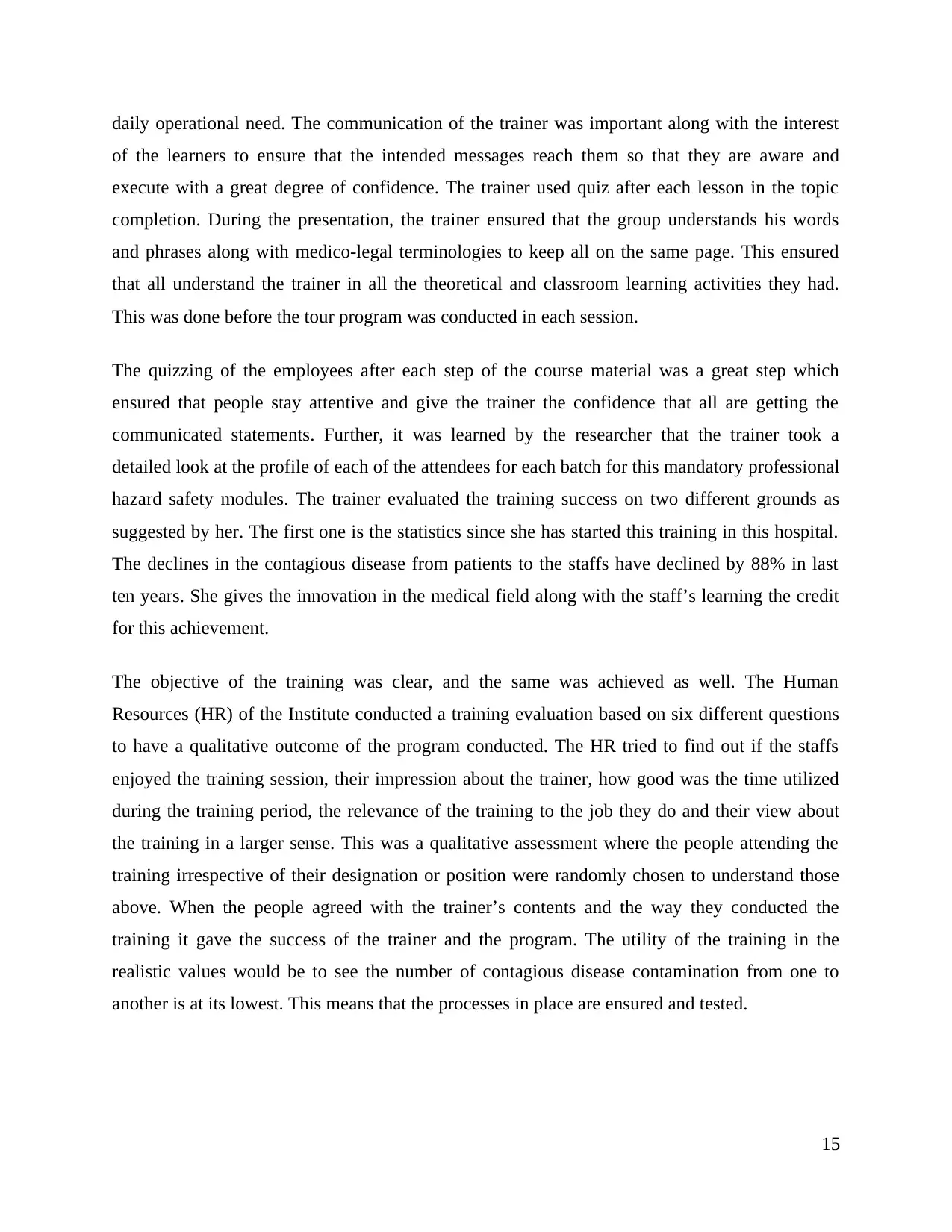
daily operational need. The communication of the trainer was important along with the interest
of the learners to ensure that the intended messages reach them so that they are aware and
execute with a great degree of confidence. The trainer used quiz after each lesson in the topic
completion. During the presentation, the trainer ensured that the group understands his words
and phrases along with medico-legal terminologies to keep all on the same page. This ensured
that all understand the trainer in all the theoretical and classroom learning activities they had.
This was done before the tour program was conducted in each session.
The quizzing of the employees after each step of the course material was a great step which
ensured that people stay attentive and give the trainer the confidence that all are getting the
communicated statements. Further, it was learned by the researcher that the trainer took a
detailed look at the profile of each of the attendees for each batch for this mandatory professional
hazard safety modules. The trainer evaluated the training success on two different grounds as
suggested by her. The first one is the statistics since she has started this training in this hospital.
The declines in the contagious disease from patients to the staffs have declined by 88% in last
ten years. She gives the innovation in the medical field along with the staff’s learning the credit
for this achievement.
The objective of the training was clear, and the same was achieved as well. The Human
Resources (HR) of the Institute conducted a training evaluation based on six different questions
to have a qualitative outcome of the program conducted. The HR tried to find out if the staffs
enjoyed the training session, their impression about the trainer, how good was the time utilized
during the training period, the relevance of the training to the job they do and their view about
the training in a larger sense. This was a qualitative assessment where the people attending the
training irrespective of their designation or position were randomly chosen to understand those
above. When the people agreed with the trainer’s contents and the way they conducted the
training it gave the success of the trainer and the program. The utility of the training in the
realistic values would be to see the number of contagious disease contamination from one to
another is at its lowest. This means that the processes in place are ensured and tested.
15
of the learners to ensure that the intended messages reach them so that they are aware and
execute with a great degree of confidence. The trainer used quiz after each lesson in the topic
completion. During the presentation, the trainer ensured that the group understands his words
and phrases along with medico-legal terminologies to keep all on the same page. This ensured
that all understand the trainer in all the theoretical and classroom learning activities they had.
This was done before the tour program was conducted in each session.
The quizzing of the employees after each step of the course material was a great step which
ensured that people stay attentive and give the trainer the confidence that all are getting the
communicated statements. Further, it was learned by the researcher that the trainer took a
detailed look at the profile of each of the attendees for each batch for this mandatory professional
hazard safety modules. The trainer evaluated the training success on two different grounds as
suggested by her. The first one is the statistics since she has started this training in this hospital.
The declines in the contagious disease from patients to the staffs have declined by 88% in last
ten years. She gives the innovation in the medical field along with the staff’s learning the credit
for this achievement.
The objective of the training was clear, and the same was achieved as well. The Human
Resources (HR) of the Institute conducted a training evaluation based on six different questions
to have a qualitative outcome of the program conducted. The HR tried to find out if the staffs
enjoyed the training session, their impression about the trainer, how good was the time utilized
during the training period, the relevance of the training to the job they do and their view about
the training in a larger sense. This was a qualitative assessment where the people attending the
training irrespective of their designation or position were randomly chosen to understand those
above. When the people agreed with the trainer’s contents and the way they conducted the
training it gave the success of the trainer and the program. The utility of the training in the
realistic values would be to see the number of contagious disease contamination from one to
another is at its lowest. This means that the processes in place are ensured and tested.
15
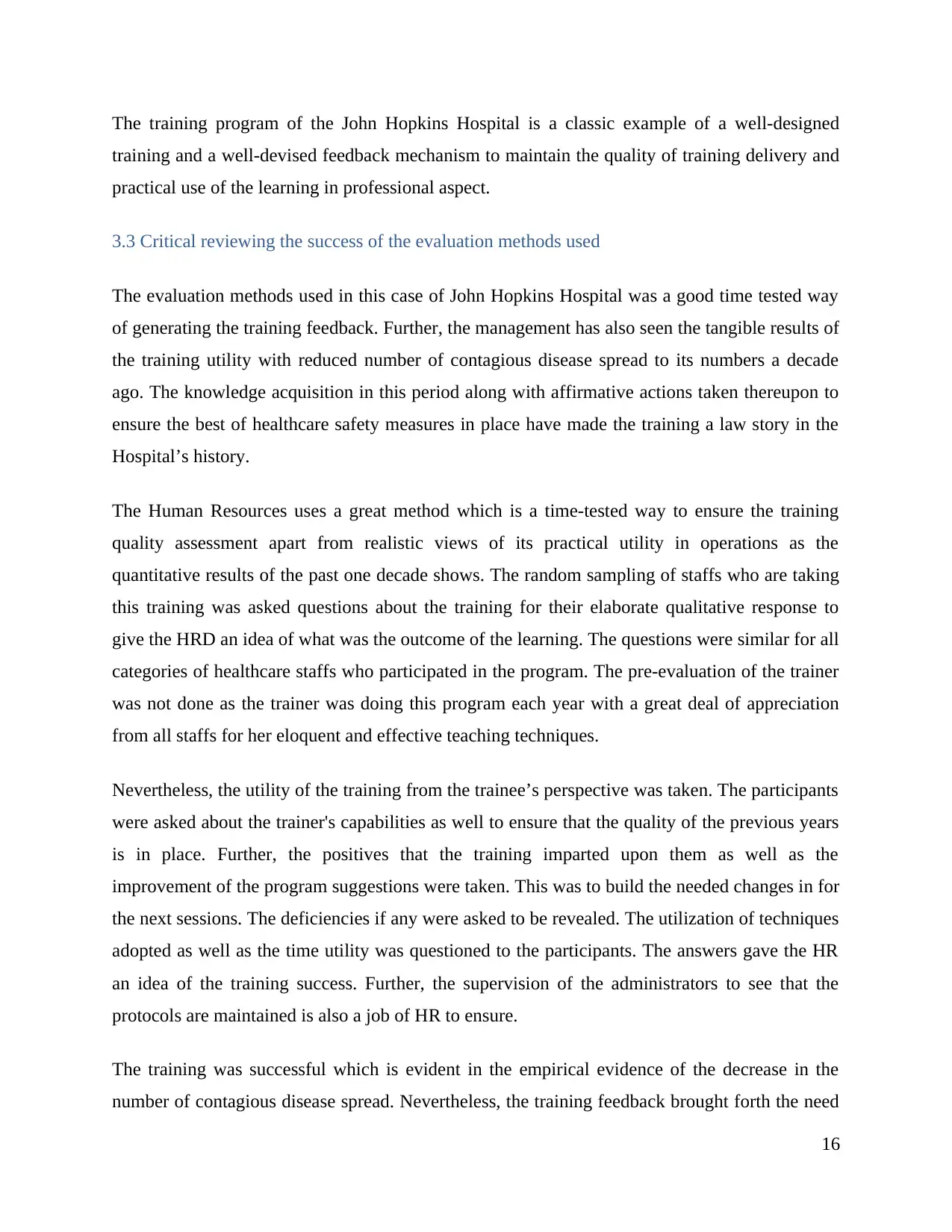
The training program of the John Hopkins Hospital is a classic example of a well-designed
training and a well-devised feedback mechanism to maintain the quality of training delivery and
practical use of the learning in professional aspect.
3.3 Critical reviewing the success of the evaluation methods used
The evaluation methods used in this case of John Hopkins Hospital was a good time tested way
of generating the training feedback. Further, the management has also seen the tangible results of
the training utility with reduced number of contagious disease spread to its numbers a decade
ago. The knowledge acquisition in this period along with affirmative actions taken thereupon to
ensure the best of healthcare safety measures in place have made the training a law story in the
Hospital’s history.
The Human Resources uses a great method which is a time-tested way to ensure the training
quality assessment apart from realistic views of its practical utility in operations as the
quantitative results of the past one decade shows. The random sampling of staffs who are taking
this training was asked questions about the training for their elaborate qualitative response to
give the HRD an idea of what was the outcome of the learning. The questions were similar for all
categories of healthcare staffs who participated in the program. The pre-evaluation of the trainer
was not done as the trainer was doing this program each year with a great deal of appreciation
from all staffs for her eloquent and effective teaching techniques.
Nevertheless, the utility of the training from the trainee’s perspective was taken. The participants
were asked about the trainer's capabilities as well to ensure that the quality of the previous years
is in place. Further, the positives that the training imparted upon them as well as the
improvement of the program suggestions were taken. This was to build the needed changes in for
the next sessions. The deficiencies if any were asked to be revealed. The utilization of techniques
adopted as well as the time utility was questioned to the participants. The answers gave the HR
an idea of the training success. Further, the supervision of the administrators to see that the
protocols are maintained is also a job of HR to ensure.
The training was successful which is evident in the empirical evidence of the decrease in the
number of contagious disease spread. Nevertheless, the training feedback brought forth the need
16
training and a well-devised feedback mechanism to maintain the quality of training delivery and
practical use of the learning in professional aspect.
3.3 Critical reviewing the success of the evaluation methods used
The evaluation methods used in this case of John Hopkins Hospital was a good time tested way
of generating the training feedback. Further, the management has also seen the tangible results of
the training utility with reduced number of contagious disease spread to its numbers a decade
ago. The knowledge acquisition in this period along with affirmative actions taken thereupon to
ensure the best of healthcare safety measures in place have made the training a law story in the
Hospital’s history.
The Human Resources uses a great method which is a time-tested way to ensure the training
quality assessment apart from realistic views of its practical utility in operations as the
quantitative results of the past one decade shows. The random sampling of staffs who are taking
this training was asked questions about the training for their elaborate qualitative response to
give the HRD an idea of what was the outcome of the learning. The questions were similar for all
categories of healthcare staffs who participated in the program. The pre-evaluation of the trainer
was not done as the trainer was doing this program each year with a great deal of appreciation
from all staffs for her eloquent and effective teaching techniques.
Nevertheless, the utility of the training from the trainee’s perspective was taken. The participants
were asked about the trainer's capabilities as well to ensure that the quality of the previous years
is in place. Further, the positives that the training imparted upon them as well as the
improvement of the program suggestions were taken. This was to build the needed changes in for
the next sessions. The deficiencies if any were asked to be revealed. The utilization of techniques
adopted as well as the time utility was questioned to the participants. The answers gave the HR
an idea of the training success. Further, the supervision of the administrators to see that the
protocols are maintained is also a job of HR to ensure.
The training was successful which is evident in the empirical evidence of the decrease in the
number of contagious disease spread. Nevertheless, the training feedback brought forth the need
16
Secure Best Marks with AI Grader
Need help grading? Try our AI Grader for instant feedback on your assignments.
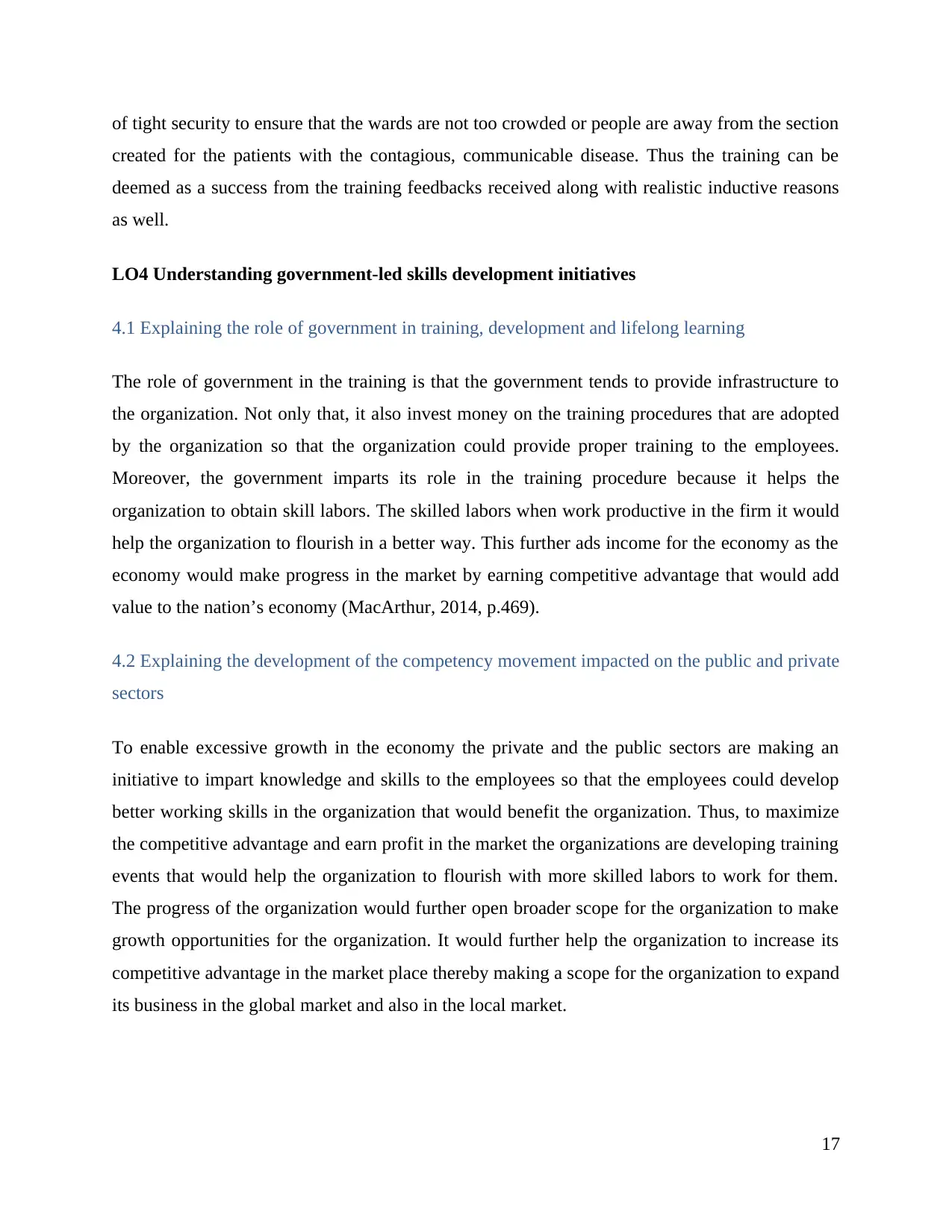
of tight security to ensure that the wards are not too crowded or people are away from the section
created for the patients with the contagious, communicable disease. Thus the training can be
deemed as a success from the training feedbacks received along with realistic inductive reasons
as well.
LO4 Understanding government-led skills development initiatives
4.1 Explaining the role of government in training, development and lifelong learning
The role of government in the training is that the government tends to provide infrastructure to
the organization. Not only that, it also invest money on the training procedures that are adopted
by the organization so that the organization could provide proper training to the employees.
Moreover, the government imparts its role in the training procedure because it helps the
organization to obtain skill labors. The skilled labors when work productive in the firm it would
help the organization to flourish in a better way. This further ads income for the economy as the
economy would make progress in the market by earning competitive advantage that would add
value to the nation’s economy (MacArthur, 2014, p.469).
4.2 Explaining the development of the competency movement impacted on the public and private
sectors
To enable excessive growth in the economy the private and the public sectors are making an
initiative to impart knowledge and skills to the employees so that the employees could develop
better working skills in the organization that would benefit the organization. Thus, to maximize
the competitive advantage and earn profit in the market the organizations are developing training
events that would help the organization to flourish with more skilled labors to work for them.
The progress of the organization would further open broader scope for the organization to make
growth opportunities for the organization. It would further help the organization to increase its
competitive advantage in the market place thereby making a scope for the organization to expand
its business in the global market and also in the local market.
17
created for the patients with the contagious, communicable disease. Thus the training can be
deemed as a success from the training feedbacks received along with realistic inductive reasons
as well.
LO4 Understanding government-led skills development initiatives
4.1 Explaining the role of government in training, development and lifelong learning
The role of government in the training is that the government tends to provide infrastructure to
the organization. Not only that, it also invest money on the training procedures that are adopted
by the organization so that the organization could provide proper training to the employees.
Moreover, the government imparts its role in the training procedure because it helps the
organization to obtain skill labors. The skilled labors when work productive in the firm it would
help the organization to flourish in a better way. This further ads income for the economy as the
economy would make progress in the market by earning competitive advantage that would add
value to the nation’s economy (MacArthur, 2014, p.469).
4.2 Explaining the development of the competency movement impacted on the public and private
sectors
To enable excessive growth in the economy the private and the public sectors are making an
initiative to impart knowledge and skills to the employees so that the employees could develop
better working skills in the organization that would benefit the organization. Thus, to maximize
the competitive advantage and earn profit in the market the organizations are developing training
events that would help the organization to flourish with more skilled labors to work for them.
The progress of the organization would further open broader scope for the organization to make
growth opportunities for the organization. It would further help the organization to increase its
competitive advantage in the market place thereby making a scope for the organization to expand
its business in the global market and also in the local market.
17
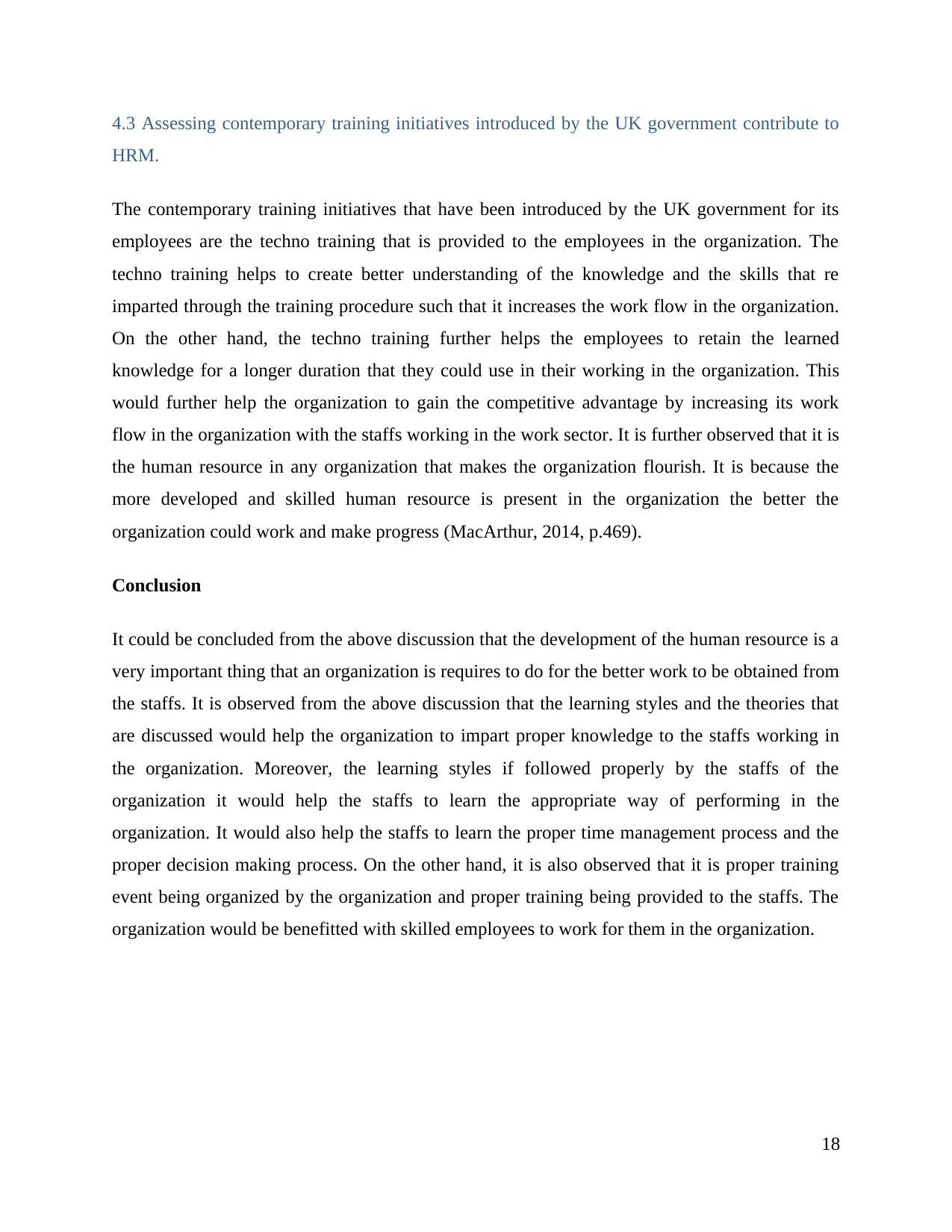
4.3 Assessing contemporary training initiatives introduced by the UK government contribute to
HRM.
The contemporary training initiatives that have been introduced by the UK government for its
employees are the techno training that is provided to the employees in the organization. The
techno training helps to create better understanding of the knowledge and the skills that re
imparted through the training procedure such that it increases the work flow in the organization.
On the other hand, the techno training further helps the employees to retain the learned
knowledge for a longer duration that they could use in their working in the organization. This
would further help the organization to gain the competitive advantage by increasing its work
flow in the organization with the staffs working in the work sector. It is further observed that it is
the human resource in any organization that makes the organization flourish. It is because the
more developed and skilled human resource is present in the organization the better the
organization could work and make progress (MacArthur, 2014, p.469).
Conclusion
It could be concluded from the above discussion that the development of the human resource is a
very important thing that an organization is requires to do for the better work to be obtained from
the staffs. It is observed from the above discussion that the learning styles and the theories that
are discussed would help the organization to impart proper knowledge to the staffs working in
the organization. Moreover, the learning styles if followed properly by the staffs of the
organization it would help the staffs to learn the appropriate way of performing in the
organization. It would also help the staffs to learn the proper time management process and the
proper decision making process. On the other hand, it is also observed that it is proper training
event being organized by the organization and proper training being provided to the staffs. The
organization would be benefitted with skilled employees to work for them in the organization.
18
HRM.
The contemporary training initiatives that have been introduced by the UK government for its
employees are the techno training that is provided to the employees in the organization. The
techno training helps to create better understanding of the knowledge and the skills that re
imparted through the training procedure such that it increases the work flow in the organization.
On the other hand, the techno training further helps the employees to retain the learned
knowledge for a longer duration that they could use in their working in the organization. This
would further help the organization to gain the competitive advantage by increasing its work
flow in the organization with the staffs working in the work sector. It is further observed that it is
the human resource in any organization that makes the organization flourish. It is because the
more developed and skilled human resource is present in the organization the better the
organization could work and make progress (MacArthur, 2014, p.469).
Conclusion
It could be concluded from the above discussion that the development of the human resource is a
very important thing that an organization is requires to do for the better work to be obtained from
the staffs. It is observed from the above discussion that the learning styles and the theories that
are discussed would help the organization to impart proper knowledge to the staffs working in
the organization. Moreover, the learning styles if followed properly by the staffs of the
organization it would help the staffs to learn the appropriate way of performing in the
organization. It would also help the staffs to learn the proper time management process and the
proper decision making process. On the other hand, it is also observed that it is proper training
event being organized by the organization and proper training being provided to the staffs. The
organization would be benefitted with skilled employees to work for them in the organization.
18
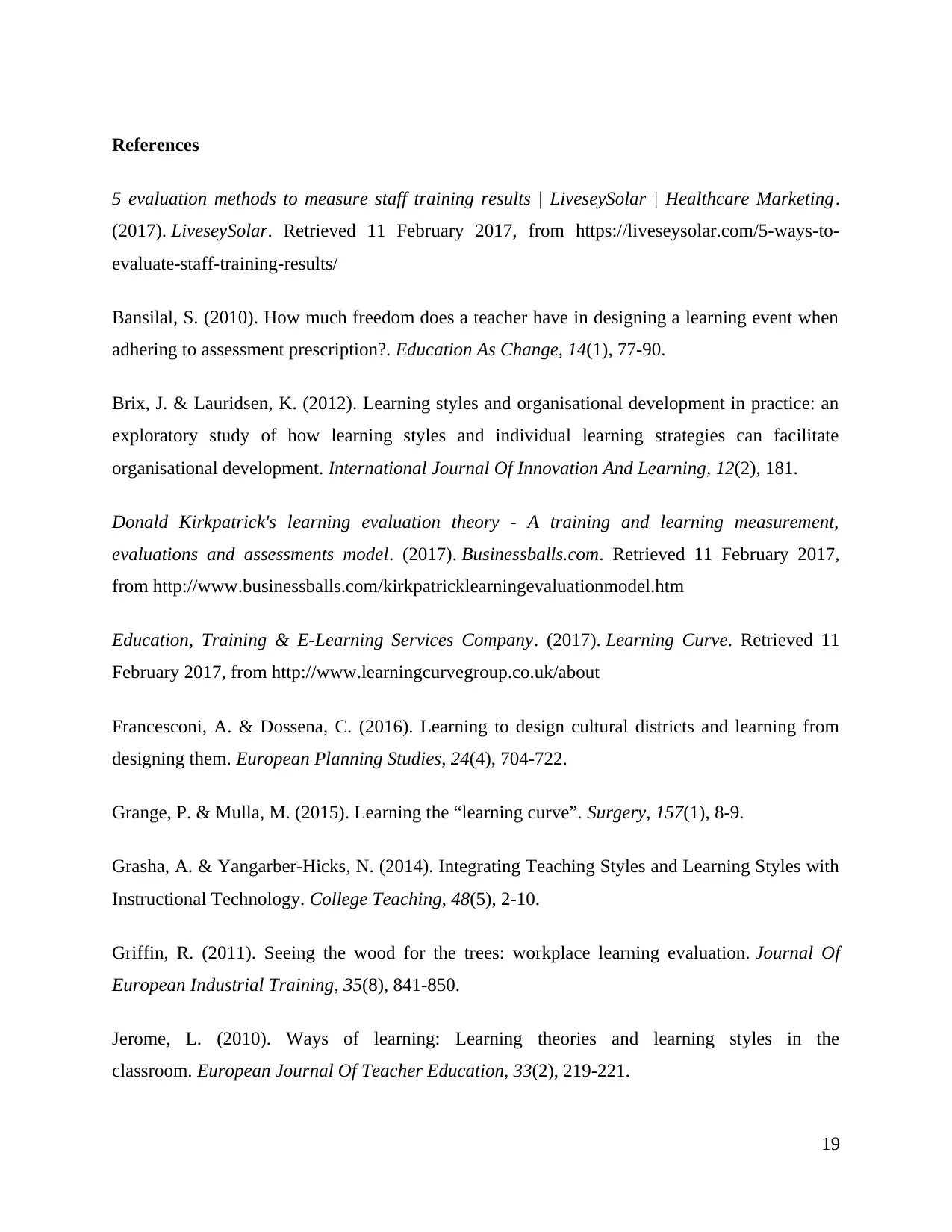
References
5 evaluation methods to measure staff training results | LiveseySolar | Healthcare Marketing.
(2017). LiveseySolar. Retrieved 11 February 2017, from https://liveseysolar.com/5-ways-to-
evaluate-staff-training-results/
Bansilal, S. (2010). How much freedom does a teacher have in designing a learning event when
adhering to assessment prescription?. Education As Change, 14(1), 77-90.
Brix, J. & Lauridsen, K. (2012). Learning styles and organisational development in practice: an
exploratory study of how learning styles and individual learning strategies can facilitate
organisational development. International Journal Of Innovation And Learning, 12(2), 181.
Donald Kirkpatrick's learning evaluation theory - A training and learning measurement,
evaluations and assessments model. (2017). Businessballs.com. Retrieved 11 February 2017,
from http://www.businessballs.com/kirkpatricklearningevaluationmodel.htm
Education, Training & E-Learning Services Company. (2017). Learning Curve. Retrieved 11
February 2017, from http://www.learningcurvegroup.co.uk/about
Francesconi, A. & Dossena, C. (2016). Learning to design cultural districts and learning from
designing them. European Planning Studies, 24(4), 704-722.
Grange, P. & Mulla, M. (2015). Learning the “learning curve”. Surgery, 157(1), 8-9.
Grasha, A. & Yangarber-Hicks, N. (2014). Integrating Teaching Styles and Learning Styles with
Instructional Technology. College Teaching, 48(5), 2-10.
Griffin, R. (2011). Seeing the wood for the trees: workplace learning evaluation. Journal Of
European Industrial Training, 35(8), 841-850.
Jerome, L. (2010). Ways of learning: Learning theories and learning styles in the
classroom. European Journal Of Teacher Education, 33(2), 219-221.
19
5 evaluation methods to measure staff training results | LiveseySolar | Healthcare Marketing.
(2017). LiveseySolar. Retrieved 11 February 2017, from https://liveseysolar.com/5-ways-to-
evaluate-staff-training-results/
Bansilal, S. (2010). How much freedom does a teacher have in designing a learning event when
adhering to assessment prescription?. Education As Change, 14(1), 77-90.
Brix, J. & Lauridsen, K. (2012). Learning styles and organisational development in practice: an
exploratory study of how learning styles and individual learning strategies can facilitate
organisational development. International Journal Of Innovation And Learning, 12(2), 181.
Donald Kirkpatrick's learning evaluation theory - A training and learning measurement,
evaluations and assessments model. (2017). Businessballs.com. Retrieved 11 February 2017,
from http://www.businessballs.com/kirkpatricklearningevaluationmodel.htm
Education, Training & E-Learning Services Company. (2017). Learning Curve. Retrieved 11
February 2017, from http://www.learningcurvegroup.co.uk/about
Francesconi, A. & Dossena, C. (2016). Learning to design cultural districts and learning from
designing them. European Planning Studies, 24(4), 704-722.
Grange, P. & Mulla, M. (2015). Learning the “learning curve”. Surgery, 157(1), 8-9.
Grasha, A. & Yangarber-Hicks, N. (2014). Integrating Teaching Styles and Learning Styles with
Instructional Technology. College Teaching, 48(5), 2-10.
Griffin, R. (2011). Seeing the wood for the trees: workplace learning evaluation. Journal Of
European Industrial Training, 35(8), 841-850.
Jerome, L. (2010). Ways of learning: Learning theories and learning styles in the
classroom. European Journal Of Teacher Education, 33(2), 219-221.
19
Paraphrase This Document
Need a fresh take? Get an instant paraphrase of this document with our AI Paraphraser
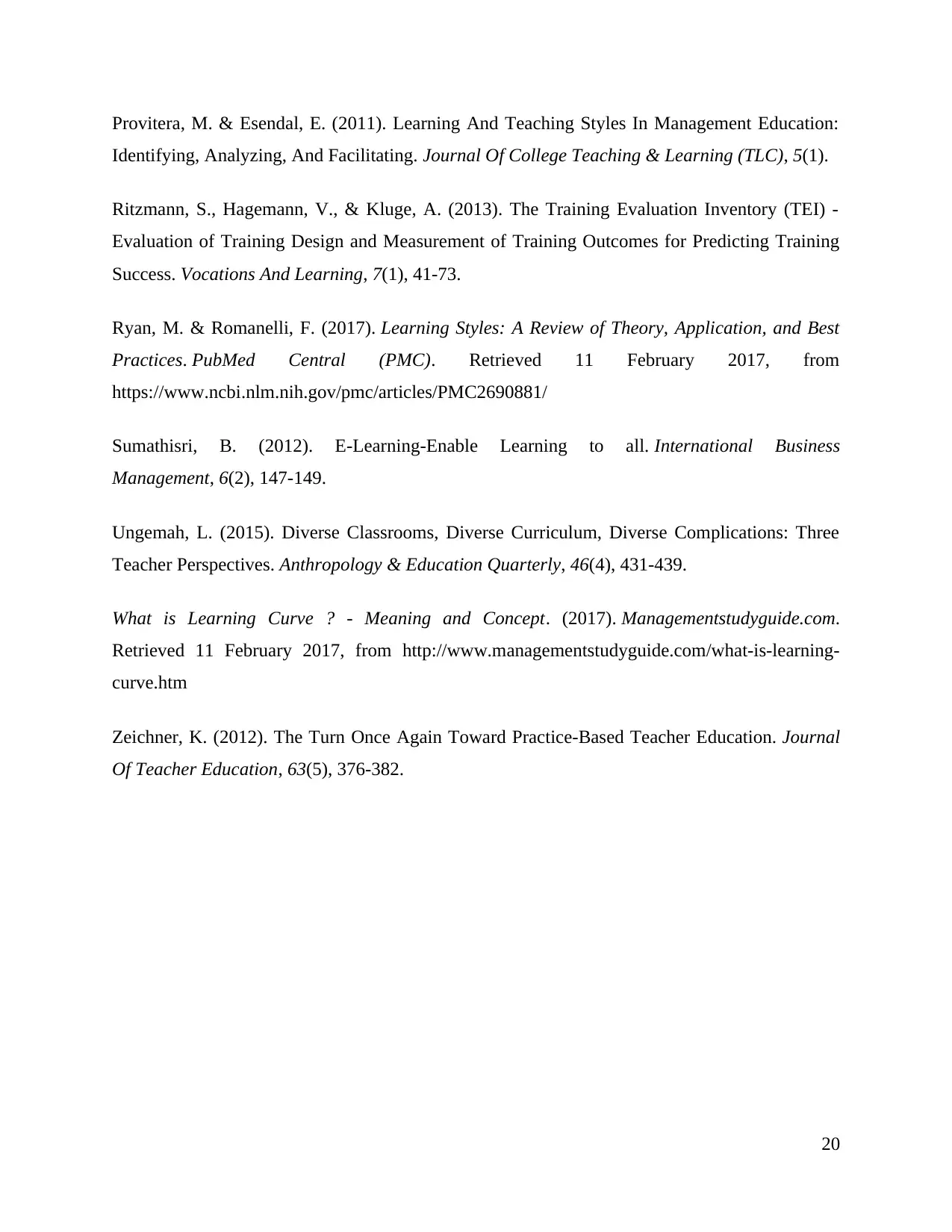
Provitera, M. & Esendal, E. (2011). Learning And Teaching Styles In Management Education:
Identifying, Analyzing, And Facilitating. Journal Of College Teaching & Learning (TLC), 5(1).
Ritzmann, S., Hagemann, V., & Kluge, A. (2013). The Training Evaluation Inventory (TEI) -
Evaluation of Training Design and Measurement of Training Outcomes for Predicting Training
Success. Vocations And Learning, 7(1), 41-73.
Ryan, M. & Romanelli, F. (2017). Learning Styles: A Review of Theory, Application, and Best
Practices. PubMed Central (PMC). Retrieved 11 February 2017, from
https://www.ncbi.nlm.nih.gov/pmc/articles/PMC2690881/
Sumathisri, B. (2012). E-Learning-Enable Learning to all. International Business
Management, 6(2), 147-149.
Ungemah, L. (2015). Diverse Classrooms, Diverse Curriculum, Diverse Complications: Three
Teacher Perspectives. Anthropology & Education Quarterly, 46(4), 431-439.
What is Learning Curve ? - Meaning and Concept. (2017). Managementstudyguide.com.
Retrieved 11 February 2017, from http://www.managementstudyguide.com/what-is-learning-
curve.htm
Zeichner, K. (2012). The Turn Once Again Toward Practice-Based Teacher Education. Journal
Of Teacher Education, 63(5), 376-382.
20
Identifying, Analyzing, And Facilitating. Journal Of College Teaching & Learning (TLC), 5(1).
Ritzmann, S., Hagemann, V., & Kluge, A. (2013). The Training Evaluation Inventory (TEI) -
Evaluation of Training Design and Measurement of Training Outcomes for Predicting Training
Success. Vocations And Learning, 7(1), 41-73.
Ryan, M. & Romanelli, F. (2017). Learning Styles: A Review of Theory, Application, and Best
Practices. PubMed Central (PMC). Retrieved 11 February 2017, from
https://www.ncbi.nlm.nih.gov/pmc/articles/PMC2690881/
Sumathisri, B. (2012). E-Learning-Enable Learning to all. International Business
Management, 6(2), 147-149.
Ungemah, L. (2015). Diverse Classrooms, Diverse Curriculum, Diverse Complications: Three
Teacher Perspectives. Anthropology & Education Quarterly, 46(4), 431-439.
What is Learning Curve ? - Meaning and Concept. (2017). Managementstudyguide.com.
Retrieved 11 February 2017, from http://www.managementstudyguide.com/what-is-learning-
curve.htm
Zeichner, K. (2012). The Turn Once Again Toward Practice-Based Teacher Education. Journal
Of Teacher Education, 63(5), 376-382.
20
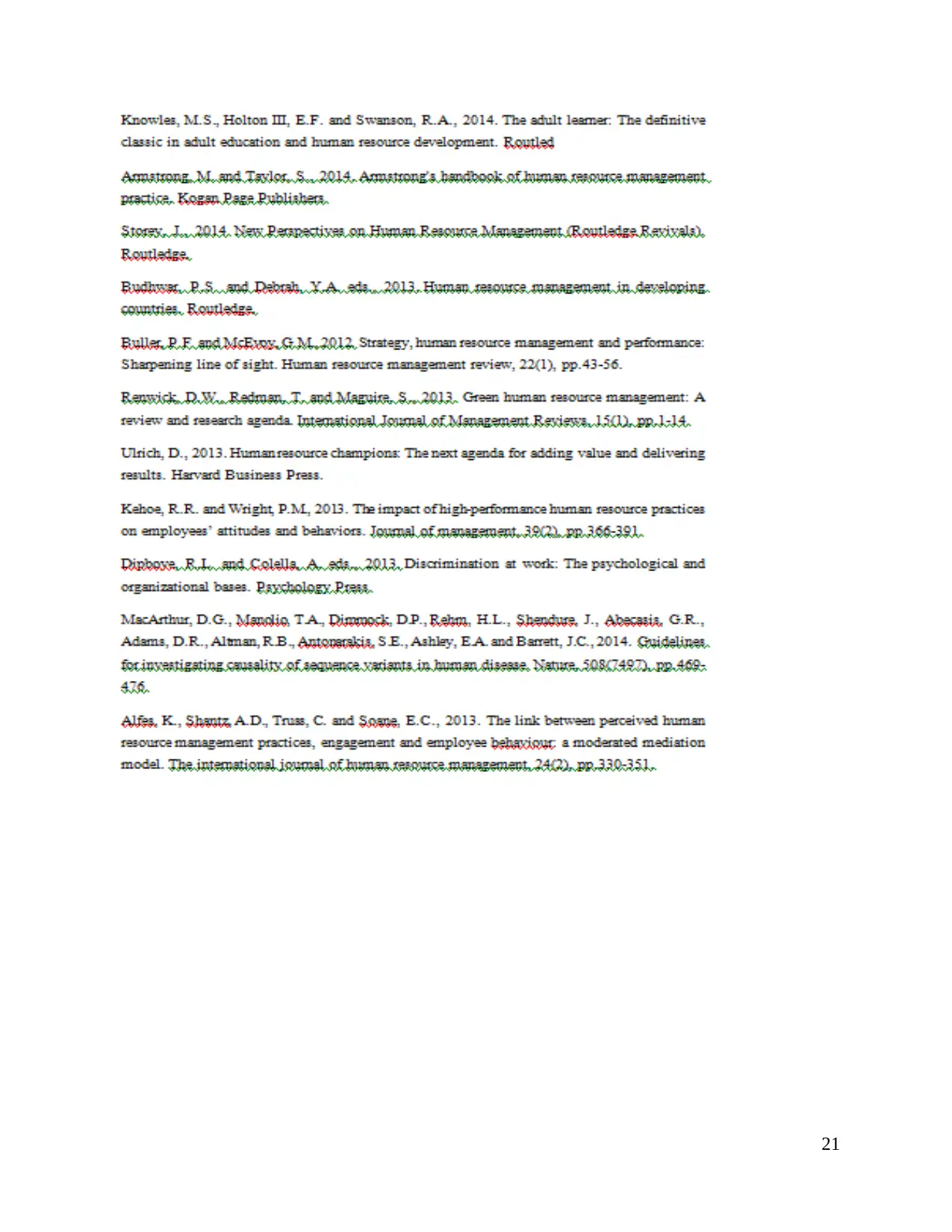
21
1 out of 21
Related Documents
Your All-in-One AI-Powered Toolkit for Academic Success.
+13062052269
info@desklib.com
Available 24*7 on WhatsApp / Email
![[object Object]](/_next/static/media/star-bottom.7253800d.svg)
Unlock your academic potential
© 2024 | Zucol Services PVT LTD | All rights reserved.





